Anisotropic Flow in Ultra-Relativistic Heavy-Ion Collisions
- 格式:pdf
- 大小:111.56 KB
- 文档页数:5
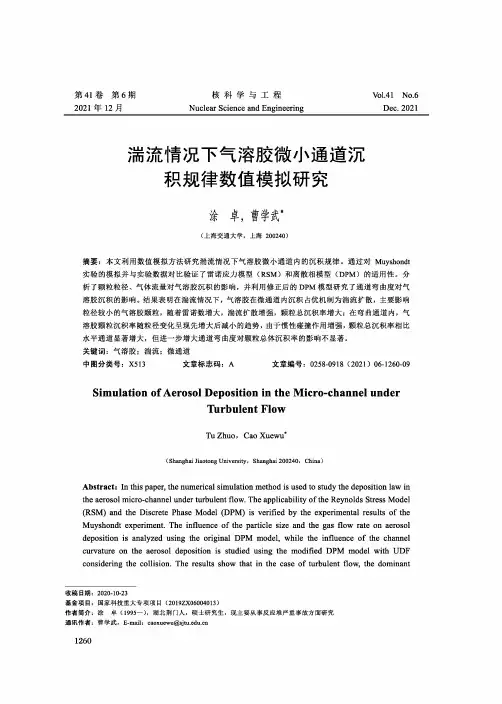
Vol.41 No.6Dec. 2021第41卷第6期2021年12月核科学与工程Nuclear Science and Engineering 湍流情况下气溶胶微小通道沉积规律数值模拟研究涂卓,曹学釘(上海交通大学,上海200240)摘要:本文利用数值模拟方法研究湍流情况下气溶胶微小通道内的沉积规律。
通过对Muyshondt实验的模拟并与实验数据对比验证了雷诺应力模型(RSM )和离散相模型(DPM )的适用性。
分 析了颗粒粒径、气体流量对气溶胶沉积的影响,并利用修正后的DPM 模型研究了通道弯曲度对气溶胶沉积的影响。
结果表明在湍流情况下,气溶胶在微通道内沉积占优机制为湍流扩散,主要影响粒径较小的气溶胶颗粒,随着雷诺数增大,湍流扩散增强,颗粒总沉积率增大;在弯曲通道内,气 溶胶颗粒沉积率随粒径变化呈现先增大后减小的趋势,由于惯性碰撞作用增强,颗粒总沉积率相比 水平通道显著增大,但进一步增大通道弯曲度对颗粒总体沉积率的影响不显著。
关键词:气溶胶;湍流;微通道中图分类号:X513文章标志码:A文章编号:0258-0918 (2021) 06-1260-09Simulation of Aerosol Deposition in the Micro-channel underTurbulent FlowTu Zhuo , Cao Xuewu a(Shanghai Jiaotong University, Shanghai 200240, China)Abstract : In this paper, the numerical simulation method is used to study the deposition law inthe aerosol micro-channel under turbulent flow. The applicability of the Reynolds Stress Model(RSM) and the Discrete Phase Model (DPM) is verified by the experimental results of the Muyshondt experiment. The influence of the particle size and the gas flow rate on aerosol deposition is analyzed using the original DPM model, while the influence of the channel curvature on the aerosol deposition is studied using the modified DPM model with UDFconsidering the collision. The results show that in the case of turbulent flow, the dominant收稿日期:2020-10-23基金项目:国家科技重大专项项目(2019ZX06004013)作者简介:涂卓(1995—),湖北荆门人,硕士研究生,现主要从事反应堆严重事故方面研究通讯作者:曹学武,E-mail : 1260mechanism of the aerosol deposition in the microchannel is turbulent diffusion.Turbulent diffusion mainly affects aerosol particles with smaller diameters.As the Reynolds number increases,turbulent diffusion increases,the overall particle deposition rate increases.In the curved channel,the deposition rate of aerosol particles first increases and then decreases with the change of the particle size.Due to the enhanced inertial collision effect,the overall particle deposition rate increases significantly compared with the horizontal channel.But further increasing the channel curvature has no significant effect on the overall particle deposition rate.Key words:Aerosol;Turbulent flow;Micro-channel当反应堆发生严重事故时,安全壳内会弥散大量放射性气溶胶,气溶胶可通过安全壳上的微小缝隙泄漏进入环境中。
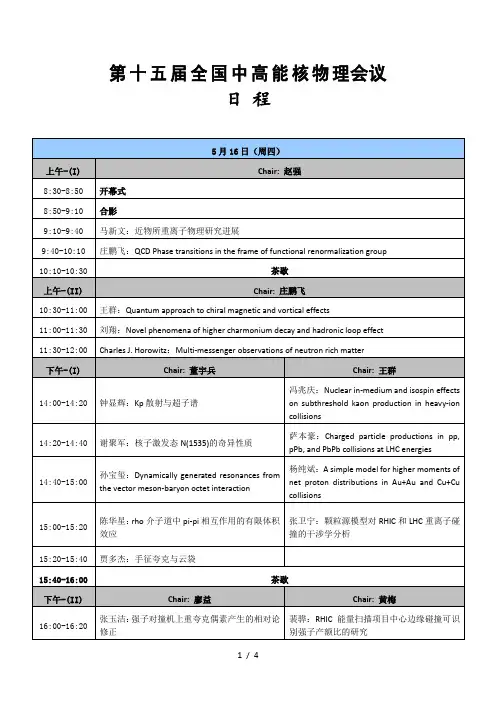
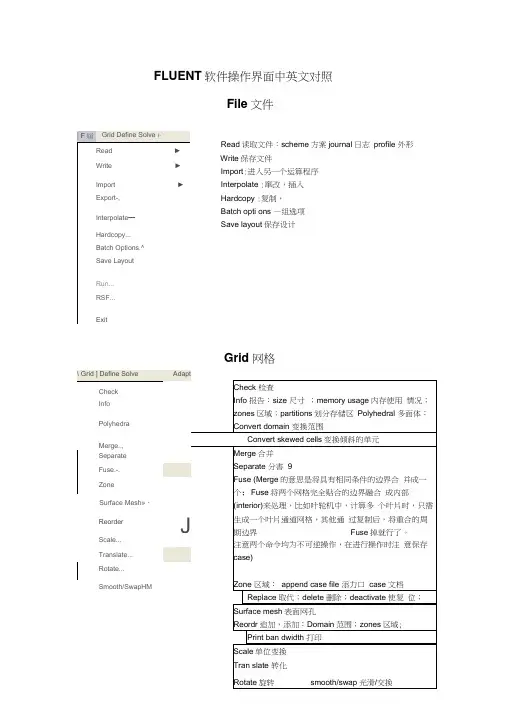
FLUENT 软件操作界面中英文对照File 文件Read 读取文件:scheme 方案journal 日志 profile 外形 Write 保存文件 Import :进入另一个运算程序 Interpolate :窜改,插入Hardcopy :复制,Batch opti ons —组选项Save layout 保存设计 Grid 网格| F 屆 Grid Define Solve i-Read► Write►Import ► Export-, Interpolate —Hardcopy...Batch Options.^Save LayoutRun...RSF...ExitDefine Models模型:solver解算器Pressure based 基于压力Den sity based基于密度末解用丁 pressure based,雀改用Censity based 岀观不苻合秦相36的摄不,请甸pres 羊WE base d Al density based 慎仆则迢.41刊卜 IS 况?北外.血OC ・EHU ^ cotipled >(/^ ptiaw ccupl ed simple 可这孔 & pimple ijEpiso 逞划.--■轟=Sortg 冲-丸布时制* ^jfe-5-6 1844DOden ba&ed 亘工F 吋.压聲血ptessurt ba$«i 适可于那可乐册斤"dens Ply based 把丸“河悴掏t :至殳嗟之一.刑牛可爪門d 的创R 监當歎1一,般如人锻暮叫人丄有用 轴怀,火薩墟迭牛才H5)-0 程:yje8D8-丸布门 1叫;20GS-3-7 10-2ODQ歆;I :谢PrflSsdrfl-Bawd Soker ^Fluflnt 它星英于压力快的束解孤便丹的圮压力修止畀法"求释旳控制片悝足标联式的,擅K 家鮮不町压縮舐Mb 对于町压砂也可旦索麟;Fk«nl 6-3 tl 前的I 板』冷孵臥 B fjS4^r«^at«d &Olvar fli Cfruptod Solvtr,的实也fltje Pr#4iurft-ea5<KJ ScFvAi 约两种虽幵方ib应理拈Fluent 氐J 眇坝犢型小的.它拈垒于曲喪红旳求聲塞,最辑的出H .也桿 艮先■那式的.丰誓■載密式冇Roz AU$hk>谏方法的初和&让Fhwrt 耳有比我甘的求IT 可压胃(说 劫謹力,們耳帕榕式淮冇琴加IF 科限闾辉,倒比还丰A 完荐匚Coupted 的算送t 对子慨站何Hh 地们足便用円匕口讷油皿购 加£未处為 性上世魅端计棒低逢刈趾.擁说的DansJty-Bjiwd Solver F ft St SiMPLEC, P 怡DE 些选以的.闪为進些ffliQl ;力修止鼻袪・不金在这种类崖的我押■中氏现泊I 建址祢匹足整用Fw»ur 护P.sed Solver 堺决昧的利底*implicit 隐式, explicit 显示Space 空间:2D , axisymmetric (转动轴), axisymmetric swirl (漩涡转动轴);Time 时间 :steady 定常,unsteady 非定常 Velocity formulatio n 制定速度: absolute 绝对的;relative 相对的Gradient option 梯度选择:以单元作基础;以节点作基础;以单元作梯度的最小正方形。
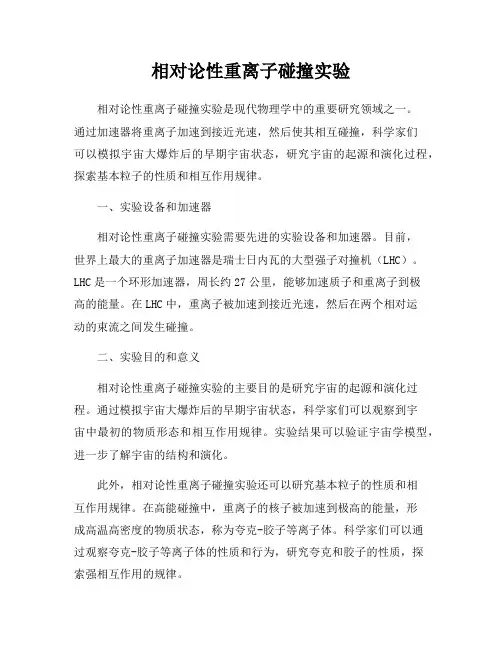
相对论性重离子碰撞实验相对论性重离子碰撞实验是现代物理学中的重要研究领域之一。
通过加速器将重离子加速到接近光速,然后使其相互碰撞,科学家们可以模拟宇宙大爆炸后的早期宇宙状态,研究宇宙的起源和演化过程,探索基本粒子的性质和相互作用规律。
一、实验设备和加速器相对论性重离子碰撞实验需要先进的实验设备和加速器。
目前,世界上最大的重离子加速器是瑞士日内瓦的大型强子对撞机(LHC)。
LHC是一个环形加速器,周长约27公里,能够加速质子和重离子到极高的能量。
在LHC中,重离子被加速到接近光速,然后在两个相对运动的束流之间发生碰撞。
二、实验目的和意义相对论性重离子碰撞实验的主要目的是研究宇宙的起源和演化过程。
通过模拟宇宙大爆炸后的早期宇宙状态,科学家们可以观察到宇宙中最初的物质形态和相互作用规律。
实验结果可以验证宇宙学模型,进一步了解宇宙的结构和演化。
此外,相对论性重离子碰撞实验还可以研究基本粒子的性质和相互作用规律。
在高能碰撞中,重离子的核子被加速到极高的能量,形成高温高密度的物质状态,称为夸克-胶子等离子体。
科学家们可以通过观察夸克-胶子等离子体的性质和行为,研究夸克和胶子的性质,探索强相互作用的规律。
三、实验过程和结果相对论性重离子碰撞实验的过程非常复杂。
首先,科学家们需要准备重离子样品,并将其注入加速器中。
然后,加速器将重离子加速到接近光速,并将其分成两个束流。
两个束流在加速器环中相对运动,最终在碰撞点发生碰撞。
在碰撞过程中,重离子的核子会发生碰撞和解体,形成夸克-胶子等离子体。
科学家们通过探测器观测夸克-胶子等离子体中产生的粒子,记录其能量、动量和轨迹等信息。
通过分析这些数据,科学家们可以重建碰撞事件的全过程,并研究夸克和胶子的性质和相互作用规律。
相对论性重离子碰撞实验已经取得了许多重要的科学成果。
例如,科学家们在LHC实验中发现了夸克-胶子等离子体,并研究了其性质和行为。
这些研究结果对理解宇宙的起源和演化,以及基本粒子的性质和相互作用规律具有重要意义。
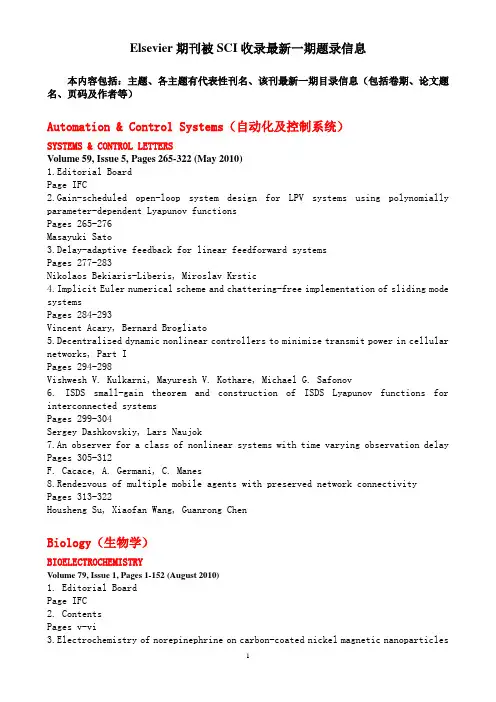
Elsevier期刊被SCI收录最新一期题录信息本内容包括:主题、各主题有代表性刊名、该刊最新一期目录信息(包括卷期、论文题名、页码及作者等)Automation & Control Systems(自动化及控制系统)SYSTEMS & CONTROL LETTERSVolume 59, Issue 5, Pages 265-322 (May 2010)1.Editorial BoardPage IFC2.Gain-scheduled open-loop system design for LPV systems using polynomially parameter-dependent Lyapunov functionsPages 265-276Masayuki Sato3.Delay-adaptive feedback for linear feedforward systemsPages 277-283Nikolaos Bekiaris-Liberis, Miroslav Krstic4.Implicit Euler numerical scheme and chattering-free implementation of sliding mode systemsPages 284-293Vincent Acary, Bernard Brogliato5.Decentralized dynamic nonlinear controllers to minimize transmit power in cellular networks, Part IPages 294-298Vishwesh V. Kulkarni, Mayuresh V. Kothare, Michael G. Safonov6. ISDS small-gain theorem and construction of ISDS Lyapunov functions for interconnected systemsPages 299-304Sergey Dashkovskiy, Lars Naujok7.An observer for a class of nonlinear systems with time varying observation delay Pages 305-312F. Cacace, A. Germani, C. Manes8.Rendezvous of multiple mobile agents with preserved network connectivity Pages 313-322Housheng Su, Xiaofan Wang, Guanrong ChenBiology(生物学)BIOELECTROCHEMISTRYVolume 79, Issue 1, Pages 1-152 (August 2010)1. Editorial BoardPage IFC2. ContentsPages v-vi3.Electrochemistry of norepinephrine on carbon-coated nickel magnetic nanoparticlesmodified electrode and analytical applicationsPages 1-5Chunli Bian, Qingxiang Zeng, Huayu Xiong, Xiuhua Zhang, Shengfu Wang4.Interaction of surface-attached haemoglobin with hydrophobic anions monitored by on-line acoustic wave detectorPages 6-10Jonathan S. Ellis, Steven Q. Xu, Xiaomeng Wang, Grégoi re Herzog, Damien W.M. Arrigan, Michael Thompson5.Electrochemical impedance spectroscopy of polypyrrole based electrochemical immunosensorPages 11-16A. Ramanavicius, A. Finkelsteinas, H. Cesiulis, A. Ramanaviciene6.Electrochemical and AFM characterization on gold and carbon electrodes of a high redox potential laccase from Fusarium proliferatumPages 17-24K. González Arzola, Y. Gimeno, M.C. Arévalo, M.A. Falcón, A. Hernández Creus7.Improvements in the extraction of cell electric properties from their electrorotation spectrumPages 25-30Damien Voyer, Marie Frénéa-Robin, Franois Buret, Laurent Nicolas8.Electrochemical DNA biosensor for the detection of specific gene related to Trichoderma harzianum speciesPages 31-36Shafiquzzaman Siddiquee, Nor Azah Yusof, Abu Bakar Salleh, Fatimah Abu Bakar, Lee Yook Heng9.Development of electrochemical DNA biosensor based on gold nanoparticle modified electrode by electroless depositionPages 37-42Shufeng Liu, Jing Liu, Li Wang, Feng Zhao10.Herbicides affect fluorescence and electron transfer activity of spinach chloroplasts, thylakoid membranes and isolated Photosystem IIPages 43-49Andrea Ventrella, Lucia Catucci, Angela Agostiano11.Nanostructured polypyrrole-coated anode for sun-powered microbial fuel cells Pages 50-56Yongjin Zou, John Pisciotta, Ilia V. Baskakov12.Anodic oxidation of 3,4-dihydroxyphenylacetic acid on carbon electrodes in acetic acid solutionsPages 57-65Slawomir Michalkiewicz, Agata Skorupa13.A voltammetric Rhodotorula mucilaginosa modified microbial biosensor for Cu(II) determinationPages 66-70Meral Yüce, Hasan Nazır, Gönül Dönmez14.Explore various co-substrates for simultaneous electricity generation and Congo red degradation in air-cathode single-chamber microbial fuel cellPages 71-76Yunqing Cao, Yongyou Hu, Jian Sun, Bin Hou15.Electrochemical oxidation of amphetamine-like drugs and application to electroanalysis of ecstasy in human serumPages 77-83E.M.P.J. Garrido, J.M.P.J. Garrido, N. Milhazes,F. Borges, A.M. Oliveira-Brett16.A l-cysteine sensor based on Pt nanoparticles/poly(o-aminophenol) film on glassy carbon electrodePages 84-89Li-Ping Liu, Zhao-Jing Yin, Zhou-Sheng Yang17.The effects of the electro-photodynamic in vitro treatment on human lung adenocarcinoma cellsPages 90-94Jolanta Saczko, Mariola Nowak, Nina Skolucka, Julita Kulbacka, Malgorzata Kotulska 18.Gadolinium blocks membrane permeabilization induced by nanosecond electric pulses and reduces cell deathPages 95-100Franck M. André, Mikhail A. Rassokhin, Angela M. Bowman, Andrei G. Pakhomov19.Scanning electrochemical microscopy activity mapping of electrodes modified with laccase encapsulated in sol–gel processed matrixPages 101-107Wojciech Nogala, Katarzyna Szot, Malte Burchardt, Martin Jönsson-Niedziolka, Jerzy Rogalski, Gunther Wittstock, Marcin Opallo20.Maltose biosensing based on co-immobilization of α-glucosidase and pyranose oxidasePages 108-113Dilek Odaci, Azmi Telefoncu, Suna Timur21.Plasma membrane permeabilization by trains of ultrashort electric pulses Pages 114-121Bennett L. Ibey, Dustin G. Mixon, Jason A. Payne, Angela Bowman, Karl Sickendick, Gerald J. Wilmink, W. Patrick Roach, Andrei G. Pakhomov22.Effect of nano-topographical features of Ti/TiO2 electrode surface on cell response and electrochemical stability in artificial salivaPages 122-129I. Demetrescu, C. Pirvu, V. Mitran23.Efficiency of the delivery of small charged molecules into cells in vitro Pages 130-135M.S. Venslauskas, S. Šatkauskas, R. Rodaitė-Riševičienė24.Carbon nanotube-enhanced cell electropermeabilisationPages 136-141Vittoria Raffa, Gianni Ciofani, Orazio Vittorio, Virginia Pensabene, Alfred Cuschieri25.Dependence of catalytic activity and long-term stability of enzyme hydrogel films on curing timePages 142-146Joshua Lehr, Bryce E. Williamson, Frédéric Barrière, Alison J. Downard26.Enzymatic flow injection method for rapid determination of choline in urine with electrochemiluminescence detectionPages 147-151Jiye Jin, Masahiro Muroga, Fumiki Takahashi, Toshio NakamuraChemistry Applied(化学应用)CARBOHYDRATE POLYMERSVolume 81, Issue 4, Pages 751-970 (23 July 2010)1.Editorial BoardPage CO22.Adsorption separation of Ni(II) ions by dialdehyde o-phenylenediamine starch from aqueous solutionPages 751-757Ping Zhao, Jian Jiang, Feng-wei Zhang, Wen-feng Zhao, Jun-tao Liu, Rong Li3.Rheological and morphological characterization of the culture broth during exopolysaccharide production by Enterobacter sp.Pages 758-764Vítor D. Alves, Filomena Freitas, Cristiana A.V. Torres, Madalena Cruz, Rodol fo Marques, Christian Grandfils, M.P. Gonçalves, Rui Oliveira, Maria A.M. Reis4.Synthesis and evaluation of N-succinyl-chitosan nanoparticles toward local hydroxycamptothecin deliveryPages 765-768Zhenqing Hou, Jing Han, Chuanming Zhan, Chunxiao Zhou, Quan Hu, Qiqing Zhang5.Synthesis and application of new sizing and finishing additives based on carboxymethyl cellulosePages 769-774Z. El-Sayed Mohamed, A. Amr, Dierk Knittel, Eckhard Schollmeyer6.Synthesis and thermo-physical properties of chitosan/poly(dl-lactide-co-glycolide) composites prepared by thermally induced phase separationPages 775-783Santos Adriana Martel-Estrada, Carlos Alberto Martínez-Pérez, José Guadalupe Chacón-Nava, Perla Elvia García-Casillas, Imelda Olivas-Armendarizparison of the immunological activities of arabinoxylans from wheat bran with alkali and xylanase-aided extractionPages 784-789Sumei Zhou, Xiuzhen Liu, Yan Guo, Qiang Wang, Daiyin Peng, Li Cao8.Nano-in-micro alginate based hybrid particlesPages 790-798Abhijeet Joshi, R. Keerthiprasad, Rahul Dev Jayant, Rohit Srivastava9.The effects of reaction conditions on block copolymerization of chitosan and poly(ethylene glycol)Pages 799-804F. Ganji, M.J. Abdekhodaie10.Thermal behaviour and interactions of cassava starch filled with glycerolplasticized polyvinyl alcohol blendsPages 805-810W.A.W.A. Rahman, Lee Tin Sin, A.R. Rahmat, A.A. Samad11.Banana fibers and microfibrils as lignocellulosic reinforcements in polymer compositesPages 811-819Maha M. Ibrahim, Alain Dufresne, Waleed K. El-Zawawy, Foster A. Agblevor12.Variability of biomass chemical composition and rapid analysis using FT-NIR techniquesPages 820-829Lu Liu, X. Philip Ye, Alvin R. Womac, Shahab Sokhansanj13.TEMPO oxidation of gelatinized potato starch results in acid resistant blocks of glucuronic acid moietiesPages 830-838Ruud ter Haar, Johan W. Timmermans, Ted M. Slaghek, Francisca E.M. Van Dongen, HenkA. Schols, Harry Gruppen14.Development of films based on quinoa (Chenopodium quinoa, Willdenow) starch Pages 839-848Patricia C. Araujo-Farro, G. Podadera, Paulo J.A. Sobral, Florencia C. Menegalli 15.Polysaccharide determination in protein/polysaccharide mixtures for phase-diagram constructionPages 849-854Jacob K. Agbenorhevi, Vassilis Kontogiorgos16.Calorimetric and light scattering study of interactions and macromolecular properties of native and hydrophobically modified hyaluronanPages 855-863Martin Chytil, Sabina Strand, Bjørn E. Christensen, Miloslav Pekař17.Spray drying of nopal mucilage (Opuntia ficus-indica): Effects on powder properties and characterizationPages 864-870F.M. León-Martínez, L.L. Méndez-Lagunas, J. Rodríguez-Ramírez18.Preparation and evaluation of nanoparticles of gum cordia, an anionic polysaccharide for ophthalmic deliveryPages 871-877Monika Yadav, Munish Ahuja19.Functional modification of agarose: A facile synthesis of a fluorescent agarose–guanine derivativePages 878-884Mihir D. Oza, Ramavatar Meena, Kamalesh Prasad, P. Paul, A.K. Siddhanta20.Characterization of maize amylose-extender (ae) mutant starches. Part III: Structures and properties of the Naegeli dextrinsPages 885-891Hongxin Jiang, Sathaporn Srichuwong, Mark Campbell, Jay-lin Jane21.Multistage deacetylation of chitin: Kinetics studyPages 892-896N. Yaghobi, F. Hormozi22.Sulfated modification, characterization and structure–antioxidantrelationships of Artemisia sphaerocephala polysaccharidesPages 897-905Junlong Wang, Hongyun Guo, Ji Zhang, Xiaofang Wang, Baotang Zhao, Jian Yao, Yunpu Wang23.Magnetic chitosan/iron (II, III) oxide nanoparticles prepared by spray-drying Pages 906-910Hsin-Yi Huang, Yeong-Tarng Shieh, Chao-Ming Shih, Yawo-Kuo Twu24.Effect of adding a small amount of high molecular weight polyacrylamide on properties of oxidized cassava starchPages 911-918Yan Liu, Xu-chao Lv, Xiao Hu, Zhi-hua Shan, Pu-xin Zhu25.Preparation of nanofibrillar carbon from chitin nanofibersPages 919-924M. Nogi, F. Kurosaki, H. Yano, M. Takano26.Preparation and characterization of cellulose acetate–Fe2O3 composite nanofibrous materialsPages 925-930Costas Tsioptsias, Kyriaki G. Sakellariou, Ioannis Tsivintzelis, Lambrini Papadopoulou, Costas Panayiotou27.Synthesis, characteristic and antibacterial activity of N,N,N-trimethyl chitosan and its carboxymethyl derivativesPages 931-936Tao Xu, Meihua Xin, Mingchun Li, Huili Huang, Shengquan Zhou28.Fast compositional analysis of ramie using near-infrared spectroscopyPages 937-941Wei Jiang, Guangting Han, Yuanming Zhang, Mengmeng Wang29.Structure characterization of polysaccharide isolated from the fruiting bodies of Tricholoma matsutakePages 942-947Xiang Ding, Su Feng, Mei Cao, Mao-tao Li, Jie Tang, Chun-xiao Guo, Jie Zhang, Qun Sun, Zhi-rong Yang, Jian Zhao30.New insights into viscosity abnormality of sodium alginate aqueous solution Pages 948-952Dan Zhong, Xin Huang, Hu Yang, Rongshi Cheng31.Structural characterization and anti-inflammatory activity of two water-soluble polysaccharides from Bellamya purificataPages 953-960Hong Zhang, Lin Ye, Kuiwu WangComputer Science, Artificial Intelligence(计算机科学,人工智能)ARTIFICIAL INTELLIGENCEVolume 174, Issue 11, Pages 639-766 (July 2010)1.Editorial BoardPage IFC2.Partial observability and learnabilityPages 639-669Loizos Michael3.Monte Carlo tree search in KriegspielPages 670-684Paolo Ciancarini, Gian Piero Favini4.Learning conditional preference networksPages 685-703Frédéric Koriche, Bruno Zanuttini5.Planning to see: A hierarchical approach to planning visual actions on a robot using POMDPsPages 704-725Mohan Sridharan, Jeremy Wyatt, Richard Dearden6.Analysis of a probabilistic model of redundancy in unsupervised information extractionPages 726-748Doug Downey, Oren Etzioni, Stephen Soderland7. Designing competitions between teams of individualsPages 749-766Pingzhong Tang, Yoav Shoham, Fangzhen LinEnergy & Fuels(能源和燃料)APPLIED ENERGYVolume 87, Issue 8, Pages 2427-2768 (August 2010)1.IFCPage IFC2. Energy balance analysis of wind-based pumped hydro storage systems in remote island electrical networksPages 2427-2437J.K. Kaldellis, M. Kapsali, K.A. Kavadias3.Energy auditing and energy conservation potential for glass worksPages 2438-2446Yingjian Li, Jiezhi Li, Qi Qiu, Yafei Xu4.Energy demand and comparison of current defrosting technologies of frozen raw materials in defrosting tunnelsPages 2447-2454Marek Bezovsky, Michal Stricik, Maria Prascakova5.Guidelines for clockspeed acceleration in the US natural gas transmission industry Pages 2455-2466Ruud Weijermars6.Multi-objective self-adaptive algorithm for highly constrained problems: Novel method and applicationsPages 2467-2478Abdelaziz Hammache, Marzouk Benali, François Aubé7.Stochastic interest rates in the analysis of energy investments: Implications on economic performance and sustainabilityPages 2479-2490Athanasios Tolis, Aggelos Doukelis, Ilias Tatsiopoulos8.Effects of the PWM carrier signals synchronization on the DC-link current in back-to-back convertersPages 2491-2499L.G. González, G. Garcerá, E. Figueres, R. González9.Efficiency improvement of the DSSCs by building the carbon black as bridge in photoelectrodePages 2500-2505Chen-Ching Ting, Wei-Shi Chao10.Integer programming with random-boundary intervals for planning municipal power systemsPages 2506-2516M.F. Cao, G.H. Huang, Q.G. Lin11. Modeling the relationship between the oil price and global food prices Pages 2517-2525Sheng-Tung Chen, Hsiao-I Kuo, Chi-Chung Chen12.Marginal production in the Gulf of Mexico – II. Model resultsPages 2526-2534Mark J. Kaiser, Yunke Yu13.Marginal production in the Gulf of Mexico – I. Historical statistics & model frameworkPages 2535-2550Mark J. Kaiser14.Assessment of forest biomass for use as energy. GIS-based analysis of geographical availability and locations of wood-fired power plants in PortugalPages 2551-2560H. Viana, Warren B. Cohen, D. Lopes, J. Aranha15.Alkaline catalyzed biodiesel production from moringa oleifera oil with optimized production parametersPages 2561-2565G. Kafuku, M. Mbarawae of two-component Weibull mixtures in the analysis of wind speed in the Eastern MediterraneanPages 2566-2573S.A. Akdağ, H.S. Bagiorgas, G. Mihalakakou17.Evaluation of wind energy investment interest and electricity generation cost analysis for TurkeyPages 2574-2580Seyit Ahmet Akdağ, Önder Güler18.The role of demand-side management in the grid integration of wind power Pages 2581-2588Pedro S. Moura, Aníbal T. de Almeida19.Synthesis of biodiesel from waste vegetable oil with large amounts of free fatty acids using a carbon-based solid acid catalystPages 2589-2596Qing Shu, Jixian Gao, Zeeshan Nawaz, Yuhui Liao, Dezheng Wang, Jinfu Wang20.A study on the overall efficiency of direct methanol fuel cell by methanol crossover currentPages 2597-2604Sang Hern Seo, Chang Sik Lee21.Study of heat transfer between an over-bed oil burner flame and a fluidized bed during start-up: Determination of the flame to bed convection coefficientPages 2605-2614Vijay Jain, Dominic Groulx, Prabir Basu22.Predictive tools for the estimation of downcomer velocity and vapor capacity factor in fractionatorsPages 2615-2620Alireza Bahadori, Hari B. Vuthaluru23. Monitoring strategies for a combined cycle electric power generatorPages 2621-2627Joshua Finn, John Wagner, Hany Bassily24. Combustion and heat transfer at meso-scale with thermal recuperationPages 2628-2639V. Vijayan, A.K. Gupta25.Part-load characteristics of direct injection spark ignition engine using exhaust gas trapPages 2640-2646Yun-long Bai, Zhi Wang, Jian-xin Wang26.Gas–liquid absorption reaction between (NH4)2SO3 solution and SO2 for ammonia-based wet flue gas desulfurizationPages 2647-2651Xiang Gao, Honglei Ding, Zhen Du, Zuliang Wu, Mengxiang Fang, Zhongyang Luo, Kefa Cen27. Direct contact PCM–water cold storagePages 2652-2659Viktoria Martin, Bo He, Fredrik Setterwall28. Fatty acid eutectic/polymethyl methacrylate composite as form-stable phase change material for thermal energy storagePages 2660-2665Lijiu Wang, Duo Meng29.Thermal characteristics of shape-stabilized phase change material wallboard with periodical outside temperature wavesPages 2666-2672Guobing Zhou, Yongping Yang, Xin Wang, Jinming Cheng30. Study on a compact silica gel–water adsorption chiller without vacuum valves: Design and experimental studyPages 2673-2681C.J. Chen, R.Z. Wang, Z.Z. Xia, J.K. Kiplagat, Z.S. Lu31. Separation characteristics of clathrate hydrates from a cooling plate forefficient cold energy storagePages 2682-2689Tadafumi Daitoku, Yoshio Utaka32. A flexible numerical model to study an active magnetic refrigerator for near room temperature applicationsPages 2690-2698Ciro Aprea, Angelo Maiorino33. Feasibility study of an ice slurry-cooling coil for HVAC and R systems in a tropical buildingPages 2699-2711Y.H. Yau, S.K. Lee34. Optimum sizing of wind-battery systems incorporating resource uncertainty Pages 2712-2727Anindita Roy, Shireesh B. Kedare, Santanu Bandyopadhyay35. Peak current mode control of three-phase boost rectifiers in discontinuous conduction mode for small wind power generatorsPages 2728-2736O. Carranza, G. Garcerá, E. Figueres, L.G. González36. Experimental flow field characteristics of OFA for large-angle counter flow of fuel-rich jet combustion technologyPages 2737-2745Weidong Fan, Zhengchun Lin, Youyi Li, Mingchuan ZhangEngineering, Electrical & Electronic(电机及电子工程)MICROELECTRONIC ENGINEERINGVolume 87, Issue 9, Pages 1655-1808 (November 2010)1. Inside Front Cover - Editorial BoardPage IFC2 PrefacePage 1655Joel Barnett3.In0.53Ga0.47As(1 0 0) native oxide removal by liquid and gas phase HF/H2O chemistriesPages 1656-1660F.L. Lie, W. Rachmady, A.J. Muscat4.A study of the interaction of gallium arsenide with wet chemical formulations using thermodynamic calculations and spectroscopic ellipsometryPages 1661-1664J. Price, J. Barnett, S. Raghavan, M. Keswani, R. Govindarajan5.The removal of nanoparticles from sub-micron trenches using megasonicsPages 1665-1668Pegah Karimi, Taehoon Kim, Juan Aceros, Jingoo Park, Ahmed A. Busnaina6.In-line control of Si loss after post ion implantation stripPages 1669-1673D. Shamiryan, D. Radisic, W. Boullart7.Removal of post-etch 193 nm photoresist in porous low-k dielectric patterning using UV irradiation and ozonated waterPages 1674-1679E. Kesters, Q.T. Le, M. Lux, L. Prager, G. Vereecke8.Repair of plasma-damaged p-SiOCH dielectric films in supercritical CO2Pages 1680-1684Jae Mok Jung, Hong Seok Kwon, Won-Ki Lee, Byung-Chun Choi, Hyun Gyu Kim, Kwon Taek Lim9.Development of compatible wet-clean stripper for integration of CoWP metal cap in Cu/low-k interconnectsPages 1685-1688Aiping Wu, Eugene Baryschpolec, Madhukar Rao, Matthias Schaller, Christin Bartsch, Susanne Leppack, Andreas Ott10.Dissolution and electrochemical impedance spectroscopy studies of thin copper oxide films on copper in semi-aqueous fluoride solutionsPages 1689-1695N. Venkataraman, S. Raghavan11.The sacrificial oxide etching of poly-Si cantilevers having high aspect ratios using supercritical CO2Pages 1696-1700Ha Soo Hwang, Jae Hyun Bae, Jae Mok Jung, Kwon Taek Lim12.Monitoring wafer cleanliness and metal contamination via VPD ICP-MS: Case studies for next generation requirementsPages 1701-1705Meredith Beebe, Scott Anderson13.Fabrication of a two-step Ni stamp for blind via hole application on PWB Pages 1707-1710In-Soo Park, Jin-Soo Kim, Seong-Hun Na, Seung-Kyu Lim, Young-Soo Oh, Su-Jeong Suh 14.Arrays of metallic nanocones fabricated by UV-nanoimprint lithographyPages 1711-1715Juha M. Kontio, Janne Simonen, Juha Tommila, Markus Pessa15.Synthesis, characterization of CeO2@SiO2 nanoparticles and their oxide CMP behaviorPages 1716-1720Xiaobing Zhao, Renwei Long, Yang Chen, Zhigang Chen16.Development of a triangular-plate MEMS tunable capacitor with linear capacitance–voltage responsePages 1721-1727M. Shavezipur, S.M. Hashemi, P. Nieva, A. Khajepour17.The correlation of the electrical properties with electron irradiation and constant voltage stress for MIS devices based on high-k double layer (HfTiSiO:N and HfTiO:N) dielectricsPages 1728-1734V. Mikhelashvili, P. Thangadurai, W.D. Kaplan, G. Eisenstein18. Intra-level voltage ramping-up to dielectric breakdown failure on Cu/porous low-k interconnections in 45 nm ULSI generationPages 1735-1740C.H. Huang, N.F. Wang, Y.Z. Tsai, C.I. Hung, M.P. Houng19. Anodic bonding of glass–ceramics to stainless steel coated with intermediate SiO2 layerPages 1741-1746Dehua Xiong, Jinshu Cheng, Hong Li, Wei Deng, Kai Ye20.Preparation of silica/ceria nano composite abrasive and its CMP behavior on hard disk substratePages 1747-1750Hong Lei, Fengling Chu, Baoqi Xiao, Xifu Tu, Hua Xu, Haineng Qiu21.Investigation on the controllable growth of monodisperse silica colloid abrasives for the chemical mechanical polishing applicationPages 1751-1755XiaoKai Hu, Zhitang Song, Haibo Wang, Weili Liu, Zefang Zhang22.Fabrication and electrical characteristics of ultrathin (HfO2)x(SiO2)1−x films by surface sol–gel method and reaction-anneal treatmentPages 1756-1759You-Pin Gong, Ai-Dong Li, Chao Zhao, Yi-Dong Xia, Di Wu23.Frequency properties of on-die power distribution network in VLSI circuits Pages 1760-1763Pavel Livshits, Yefim Fefer, Anton Rozen, Yoram Shapira24.Analytical modelling for the current–voltage characteristics of undoped or lightly-doped symmetric double-gate MOSFETsPages 1764-1768A. Tsormpatzoglou, D.H. Tassis, C.A. Dimitriadis, G. Ghibaudo, G. Pananakakis, N. Collaert25.Anti-buckling S-shaped vertical microprobes with branch springsPages 1769-1776Jung Yup Kim, Hak Joo Lee, Young-Ho Cho26.Characterization of UV photodetectors with MgxZn1−xO thin filmsPages 1777-1780Tung-Te Chu, Huilin Jiang, Liang-Wen Ji, Te-Hua Fang, Wei-Shun Shi, Tian-Long Chang, Teen-Hang Meen, Jingchang Zhong27.Barrier height temperature coefficient in ideal Ti/n-GaAs Schottky contacts Pages 1781-1784T. Göksu, N. Yıldırım, H. Korkut, A.F. Özdemir, A. Turut, A. Kökçe28.Optical coherence tomography for non-destructive investigation of silicon integrated-circuitsPages 1785-1791K.A. Serrels, M.K. Renner, D.T. Reid29.Materials selection procedure for RF-MEMSPages 1792-1795G. Guisbiers, E. Herth, B. Legrand, N. Rolland, T. Lasri, L. BuchaillotPreview PDF (303 K) | Related Articles30.Automated optical method for ultrasonic bond pull force estimationPages 1796-1804Henri Seppänen, Robert Schäfer, Ivan Kassamakov, Peter Hauptmann, Edward Hæggström31.Oxygen incorporation in TiN for metal gate work function tuning with a replacement gate integration approachPages 1805-1807Zilan Li, Tom Schram, Thomas Witters, Joshua Tseng, Stefan De Gendt, Kristin De MeyerEngineering, Industrial(工业工程)APPLIED ERGONOMICSVolume 41, Issue 5, Pages 643-718 (September 2010)1.Editorial BoardPage IFC2.Editorial for special issue of applied ergonomics on patient safetyPages 643-644Pascale Carayon, Peter Buckle3.Systems mapping workshops and their role in understanding medication errors in healthcarePages 645-656P. Buckle, P.J. Clarkson, R. Coleman, J. Bound, J. Ward, J. Brown4.Human factors in patient safety as an innovationPages 657-665Pascale Carayon5.Space to care and treat safely in acute hospitals: Recommendations from 1866 to 2008Pages 666-673Sue Hignett, Jun Lu6.Macroergonomics and patient safety: The impact of levels on theory, measurement, analysis and intervention in patient safety researchPages 674-681Ben-Tzion Karsh, Roger Brown7.Designing packaging to support the safe use of medicines at homePages 682-694James Ward, Peter Buckle, P. John Clarkson8.Reflective analysis of safety research in the hospital accident & emergency departmentsPages 695-700Robert L. Wears, Maria Woloshynowych, Ruth Brown, Charles A. Vincent9.Improving cardiac surgical care: A work systems approachPages 701-712Douglas A. Wiegmann, Ashley A. Eggman, Andrew W. ElBardissi, Sarah Henrickson Parker, Thoralf M. Sundt III10.Are hospitals becoming high reliability organizations?Pages 713-718Sebastiano Bagnara, Oronzo Parlangeli, Riccardo TartagliaEngineering, Civil(土木工程)ENGINEERING STRUCTURESVolume 32, Issue 7, Pages 1791-1956 (July 2010)1.A study of the collapse of a WWII communications antenna using numerical simulations based on design of experiments by FEMPages 1792-1800J.J. del Coz Díaz, P.J. García Nieto, A. Lozano Martínez-Luengas, J.L. Suárez Sierra 2.Evaluation study on structural fault of a Renaissance Italian palacePages 1801-1813Michele Betti, Gianni Bartoli, Maurizio Orlando3.Case study: Damage of an RC building after a landslide—inspection, analysis and retrofittingPages 1814-1820P. Tiago, E. Júlio4.Deep trench, landslide and effects on the foundations of a residential building:A case studyPages 1821-1829A. Brencich5.Forensic diagnosis of a shield tunnel failurePages 1830-1837Wei F. Lee, Kenji Ishihara6.Failure of concrete T-beam and box-girder highway bridges subjected to cyclic loading from trafficPages 1838-1845Kent K. Sasaki, Terry Paret, Juan C. Araiza, Peder Hals7.Durability problem of RC structures in Tuzla industrial zone — Two case studies Pages 1846-1860Radomir Folić, Damir Zenunović8.Transverse vibrations in existing railway bridges under resonant conditions: Single-track versus double-track configurationsPages 1861-1875M.D. Martínez-Rodrigo, J. Lavado, P. Museros9.Case study: Analytical investigation on the failure of a two-story RC building damaged during the 2007 Pisco-Chincha earthquakePages 1876-1887Oh-Sung Kwon, Eungsoo Kim10.An evaluation of effective design parameters on earthquake performance of RC buildings using neural networksPages 1888-1898M. Hakan Arslan11.Structural performance of the historic and modern buildings of the University of L’Aquila during the seismic events of April 2009Pages 1899-1924A.M. Ceci, A. Contento, L. Fanale, D. Galeota, V. Gattulli, M. Lepidi, F. Potenza14.Collapse modelling analysis of a precast soft storey building in Australia Pages 1925-1936。
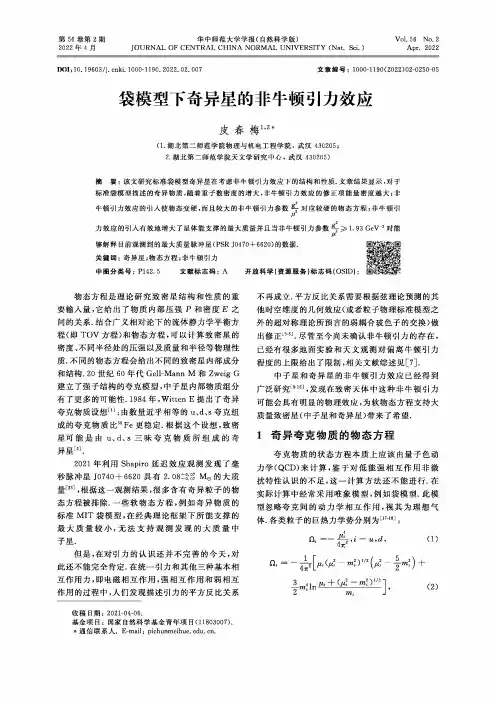
华中师范大学学报(自然科学版)JOURNAL OF CENTRAL CHINA NORMAL UNIVERSITY(Nat.Sci.)Vol.56No.2Apr.2022第56卷第2期2022年4月DOI;10.19603/ki.1000-1190.2022.02.007文章编号:1000-1190(2022)02-0250-05袋模型下奇异星的非牛顿引力效应皮春梅心(1.湖北第二师范学院物理与机电工程学院,武汉430205;2.湖北第二师范学院天文学研究中心,武汉430205)摘要:该文研究标准袋模型奇异星在考虑非牛顿引力效应下的结构和性质.文章结果显示,对于标准袋模型描述的奇异物质,随着重子数密度的增大,非牛顿引力效应的修正项能量密度越大;非牛顿引力效应的引入使物态变硬,而且较大的非牛顿引力参数4对应较硬的物态方程;非牛顿引p-力效应的引入有效地增大了星体能支撑的最大质量并且当非牛顿引力参数粤》1.93GeV-2时能够解释目前观测到的最大质量脉冲星(PSRJ0470+6620)的数据.关键词:奇异星;物态方程;非牛顿引力中图分类号:P142.5文献标志码:A开放科学(资源服务)标志码(OSID):物态方程是理论研究致密星结构和性质的重要输入量,它给出了物质内部压强P和密度E之间的关系.结合广义相对论下的流体静力学平衡方程(即TOV方程)和物态方程,可以计算致密星的密度、不同半径处的压强以及质量和半径等物理性质.不同的物态方程会给出不同的致密星内部成分和结构.20世纪60年代Gell-Mann M和Zweig G 建立了强子结构的夸克模型,中子星内部物质组分有了更多的可能性•1984年,Witten E提出了奇异夸克物质设想m:由数量近乎相等的u、d、s夸克组成的夸克物质比"Fe更稳定.根据这个设想,致密星可能是由u、d、s三味夸克物质所组成的奇异星阂.2021年利用Shapiro延迟效应观测发现了毫秒脉冲星J0740+6620具有2.08兰:器M0的大质量匚旳,根据这一观测结果,很多含有奇异粒子的物态方程被排除•一些软物态方程,例如奇异物质的标准MIT袋模型,在经典理论框架下所能支撑的最大质量较小,无法支持观测发现的大质量中子星.但是,在对引力的认识还并不完善的今天,对此还不能完全肯定•在统一引力和其他三种基本相互作用力,即电磁相互作用,强相互作用和弱相互作用的过程中,人们发现描述引力的平方反比关系不再成立.平方反比关系需要根据弦理论预测的其他时空维度的几何效应(或者粒子物理标准模型之外的超对称理论所预言的弱耦合玻色子的交换)做出修正冲].尽管至今尚未确认非牛顿引力的存在,已经有很多地面实验和天文观测对偏离牛顿引力程度的上限给出了限制,相关文献综述见[7].中子星和奇异星的非牛顿引力效应已经得到广泛研究金切,发现在致密天体中这种非牛顿引力可能会具有明显的物理效应,为软物态方程支持大质量致密星(中子星和奇异星)带来了希望.1奇异夸克物质的物态方程夸克物质的状态方程本质上应该由量子色动力学(QCD)来计算,鉴于对低能强相互作用非微扰特性认识的不足,这一计算方法还不能进行•在实际计算中经常采用唯象模型,例如袋模型.此模型忽略夸克间的动力学相互作用,视其为理想气体.各类粒子的巨热力学势分别为”购:4=u9d,(1)Q=—-^2[“3—诚)1/2(“7—号诚)+■I分3一就(2)收稿日期:2021-04-06.基金项目:国家自然科学基金青年项目(11803007). *通信联系人.E-mail:,cn.第2期皮春梅:袋模型下奇异星的非牛顿引力效应251「越,⑶其中,%和少分别为粒子的质量和化学势.通过热力学关系可以利用巨热力学势计算系统的各热力学量,如各种粒子数密度、压强和能量密度等•第Ki=“,d,s,e)种粒子的数密度是夸克物质通过弱相互作用保持化学平衡•各类粒子化学势M之间满足平衡条件“d=(5)作为一个稳定系统,还应当满足电中性条件要求:91可九一可(加+%)一%=0.(6)重子数密度为n b=-y(n…+n d+n s).(7)不考虑非牛顿引力效应时,能量密度为E q=〉:(fit+円71/)+B,(8)i=u i d,s i e相应地,压强为P q=—工Hi—B,(9)i—u,d,s,e这里B是袋常数.本文忽略u夸克和d夸克的质量,s夸克的流质量取%=93MeV[19],选取具有代表性的袋常数B1/4=140MeV.2非牛顿引力效应根据Fujii理论购,非牛顿引力可以表述为在传统的引力势基础上增加一个汤川型的修正项,即V(r)=_&8加1况2(1+幺貢力)=rV n G)+VVG),(10)其中,Gg=6.6710X10-n N•m2/kg2,a是无量纲的汤川引力强度参数以是短程相互作用的特征长度•利用矢量玻色子交换模型,,=丄=I g2A卩,a士4k G#,其中,土分别代表标量(+)和矢量(一)玻色子,“,g 和分别是玻色子一重子耦合常数,玻色子质量和重子质量.非牛顿引力效应可近似地通过物态方程来描述,而保持爱因斯坦场方程不变.汤川型的修正项对能量密度的贡献为E y=壽j"3角(工1)盍(zi)d工1d丄2,(11)其中,v是归一化常数,『=z|N—云|.上式中重子数密度前的因子3的引入是因为每个夸克的重子数为1/3E14].考虑到m(Hi)=n b(rc2)=«6E21_22],并且取V=4k R3z/3,有E y=reT^dr,(12)通过积分很容易得到,Ey=弊谄口一(1+迹)尹].(13)因为原则上研究对象很大,可以取Rff故Ey=(14)综上,考虑非牛顿引力效应,奇异夸克物质的能量密度为E=E q+E y,(15)其中E q由(8)式给出.相应地,汤川型修正项对压强的贡献为(16)假定玻色子质量与介质密度无关凹,有P y=^~2n b-(17)2V-考虑非牛顿引力效应,奇异夸克物质的压强为P=P Q+P Y,(18)其中,P q由(9)式给出.这里需要指出,非牛顿引力理论是超越了广义相对论的理论.众所周知,平方反比关系是广义相对论在弱场低速情形下的近似.非牛顿引力理论(具体到本文,是在传统的引力势基础上增加一个汤川型的修正项)下,平方反比关系不成立.实际上,超越相对论的其他一些引力理论,如f(R)理论,在弱场低速情形下也不满足平方反比关系⑷.如Shao所述盟】,广义相对论的场方程中有两个部分,其一是时空几何,其二是物质与能量.在对广义相对论做修正时,既可以修正时空几何部分,也可以修正物质与能量部分,两种途径是简并的.在研究非牛顿引力对奇异星质量一半径关系(图3)的影响时采用公式(15)和(18)所给出状态方程,这实际上是修正了广义相对论的物质与能量部分,而广义相对论的时空几何部分保持不变.于是,仍然可以采用原来的广义相对论所推导出的TOV方程.252华中师范大学学报(自然科学版)第56卷3数值计算结果与讨论图1为考虑非牛顿引力后奇异星的物态方程,其中非牛顿引力参数4分别取0,2,5,11 GeV-2.圏1表明,非牛顿引力效应的引入使物态变硬,而 且非牛顿引力参数越大,对应的物态方程越硬.5(4(京201 OC U J • A o s y d500I 000 1 500 2 000£/(MeV ' fnf ,)注;曲线旁边的数值代表非牛顿引力参数少的取值,单位 是 GeV-2.图1考虑非牛顿引力后MIT 物态方程的密度-压强关系Fig. 1 Relation between pressure and energy density in MIT model of quark matter with the nonrNewtonian gravity图2给出了不同参数下汤川型非牛顿引力效 应的修正项对能量密度的贡献随重子数密度的变 化.随着重子数密度的增大,修正项能量密度越大.其实从方程(14)中就可以看出修正项能量密度随着重子数密度的平方单调增加的.质量半径关系是星体最重要的性质之一,图3 给出了引入和没有引入非牛顿引力效应的情况下 奇异星的质量半径关系.从图中可以发现,随着非牛顿引力参数粤的增大,相应可支撑的最大奇异星质量也增大.当4 = 0 GeV-2,即没有引入非牛 顿引力效应时,可支持的奇异星最大质量约为1. 9M® ,而当^ = 11 GeV'2时支持的最大质量大约为2. 56M®.这表明越大的非牛顿引力参数对应的物态方程越硬,支持的奇异星最大质量越大.对于奇异物质的标准袋模型状态方程,加入非牛顿引 力效应并且非牛顿引力参数4^1-93 GeV 一2能够P-解释目前观测到的最大质量脉冲星(PSR J0470 +6620)的数据.08649-00064 22 11111(c w -a s h w 2 4 6 « 10 12 14nji'o注:no = 0.17 fm-3是标准核饱和密度.图2汤川型非牛顿引力效应的修正项对能量密度的贡献随重子数密度的变化Fig. 2 The extra density due to the nonrNewtoniancomponent as the function of —注:红色实线对应于£ = 1. 93 GeV"2,此时理论给出 的奇异星最大质量是2. 08M®.绿色实线给出了目前观 测中发现的最大质量脉冲星(PSR J0470 + 6620)的数据,它的质量是2・08M®・图3引入和没有引入非牛顿引力效应的情况下奇异星的质量一半径关系Fig. 3 The mass-radius relation of strange stars withseveral typical sets of model parameters图4给岀了观测到的脉冲星最大质量(PSRJ0470 + 6620,2. 08M @ )对非牛顿引力参数空间的限制.图中标号为“1”至“9”的黑色曲线对应于其他 不同实验对非牛顿引力参数空间的限制曲线“1”和“2”分别对应于质子一中子散射实验在标量第2期皮春梅:袋模型下奇异星的非牛顿引力效应253玻色子和矢量玻色子情形下的限制⑵];“3”和“4”分别对应于原子核荷半径和束缚能的限制[旳;“5”和“6”的限制分别来自He原子光谱和208pb散射实验[旳;“7”的限制来自对卡西米尔力的测量沏1;“8”的限制来自中子一氤气散射实验血打“9”的限制来自于金和硅组分的转动源与待测质量间引力的测量㉔.红色实线对应于粤=1.93GeV"2,此时奇异星最大质量是2.08M®.作为参考,红色虚线对应于4=11GeV",此时奇异星最大质量是2.56M©.在图中红色实线上方的区域(对应于粤4 >1.93GeV'2)能够允许的奇异星最大质量大于2.08M®.这个区域符合一些其他实验(如“5”)给出的限制,但是却不能符合另一些实验(如“6”“8”“9”)所给出的限制.bg4图4观测到的脉冲星最大质量(2.08M®)对非牛顿引力参数空间的限制Fig.4Upper bounds on the strength parameter|a|respectively,the bosonrnucleon coupling constant g asa function of the range of the Yukawa force fi andmass if hypothetical bosons,set by differrent experiments 4总结本文主要研究了考虑非牛顿引力效应下标准带模型奇异星的结构和性质,包括奇异物质的密度一压强关系、非牛顿引力效应的修正项对能量密度的贡献随重子数密度的变化以及星体的质量一半径关系.结果表明,非牛顿引力效应的引入使物态变硬,而且较大的非牛顿引力参数对应较硬的物态方程;随着重子数密度的增大,修正项能量密度越大;星体能支撑的最大质量在引入非牛顿引力效应的情况下有效地增大了.而且,对于奇异物质的标准袋模型状态方程,加入非牛顿引力效应并且非牛顿引力参数粤$1.93GeV'2能够解释目前观测到卩的最大质量脉冲星(PSR J0470+6620)的数据.参考文献:[1]WITTEN E・Cosmic separation of phases[J]・PhysicalReview D,1984,30(2):272-285・[2]ALCOCK C,OLINTO A V.Exotic phases of hadronicmatter and their astrophysical application]J].Annual Review of Nuclear and Particle Science»1988^38(8)j161-184・[3]CROMARTIE H・Relativistic Shapiro delay measurementsof an extremely massive millisecond pulsar[J].Nature Astronomy,2020,4:72-76.[4]FONSECA E.Refined mass and geometric measurements ofthe high-mass PSR J0740+6620口/OL]・The Astrophysical Journal Letters,2021r915(1)[2021-09-10X https;//doi, org/10,3847/2041-8213/ac0368,[5]ADELBERGER E G,GUNDLACH J H?HECKEL B R,etal・Torsion balance experiments j a low-energy frontier of particle physics]Jl Progress in Particle and Nuclear Physics’2009,62(1):102-134.[6]LI B A,KRASTEV P G,WEN D H,et al.Towardsunderstanding astrophysical effects of nuclear symmetry energy[J].European Physical Journal A,2019,55(7)s 117-191・[7]MURATA J,TANAKA S.Review of short-range gravityexperiments in the LHC eraEJ/OL]・Classical and Quantum Gravity,2015,32(3)[2021-09-10].https;///10.1088/0264-9381/32/3/033001・[8]KRIVORUCHENKO M I,SIMKOVIC F,FAESSLER A.Constraints for weakly interacting light Bosons from existence of massive neutron stars[J/OL].Physical Review D,2009,79[2021-09-10https://dot org/10.1103/ PhysRevD.79.125023.[9]WEN D H,LI B A,CHEN L W.Supersoft symmetry energyencountering non-Newtonian gravity in neutron stars[J/ OL]・Physical Review Letters,2009f103(21)[2021-09-10],https;//doL org/10.1103/PHYSREVLETT.103,211102・[10]SULAKSONO A,KASMUDIN M・Effects of in-mediummodification of weakly interacting light Boson mass inneutron stars]J]・Modem Physics Letters A,2011.926(5〉:367-375.[11]ZHANG D R,YIN P L,WANG W,et al.Effects of aweakly interacting light U Boson on the nuclear equation ofstate and properties of neutron stars in relativistic modelsEJ/0L1Physical Review C,2011,83(3)[2021-09-10],https;//doi,org/10,1103/PhysRevC,83,035801・[12]YAN J,WEN D H.R-mode instability of neutron star withnon-Newtonian gravityCJ],Communications in TheoreticalPhysics,20139$9(1儿47・52・254华中师范大学学报(自然科学版)第56卷[13]LIN W,LI B A,CHEN L W,et al.Breaking the EOS-gravitydegeneracy with masses and pulsating frequencies of neutronstarsUJ/OL].Journal o£Physics G,2014,41(7)[2021-09-10H.https;///10.1088/0954-3899/41/7/075203.[14]LU Z Y,PENG G X,ZHOU K.Effects of non-Newtoniangravity on the properties of strange stars[J].Research in.Astronomy and Astrophysics,2017,17(2):11-16.口5]YU Z,XU Y,ZHANG G Q,et al.Effects o£a weakly interacting light U Boson on protoneutron stars includingthe hyperon-hyperon,interactions[J].Communications in.Theoretical Physics,2018»69(4);417-424.:16]YANG S H,PI C M,ZHENG X P,et al.Non-Newtonian gravity in strange quark stars and constraints from theobservations of PSR J0740+6620and GW170817[J丄TheAstrophysical Journal,2020,902(1):32-3&「17]FARHI E,JAFFE R L.Strange matter E J].Physical Review D,1984,30(11):2379-2390.[18]WEBER F.Strange quark matter and compact stars[J].Progress in Particle and Nuclear Physics»2005,54(1);193-28&「19]ZYLA P A,BARNETT R M,BERINGER J,et al.,Review of particle physics[J/OL].Progress in Theoretical andExperimental Physics,2020(8)[2021-09-10].https://doi.org/10.1093/ptep/ptaal04.[20]FUJII Y.Dilaton and possible non-Newtonian gravity[J].Nature Physical Science,1971,234(44):5-7.[21]ALCOCK C,FARHI E,OLINTO A.Strange starsEJl TheAstrophysical Journal,1986,310;261-272.[22]MADSEN J.Physics and astrophysics of strange quarkmatter[J].Lecture Notes in Physics,Berlin SpringerVerlag,1999,516:162-203.[23]SHAO L J.Degeneracy in studying the supranuclearequation of state and modified gravity with neutron starsEJ/OLD.AIP Conference Proceedings,2019,2127(1)[2021-09-10].https;///10.1063/1.5117806.[24]KAMYSHKOV Y,TITHOF J,VYSOTSKY M.Bounds onnew light particles from high-energy and very smallmomentum transfer np elastic scattering data[J/OL].Physical Review D,2008,78(11)[2021-09-10J.https:///10.1103/PhysRevD.78,114029.[25]XU J,LI B A,CHEN L W»et al.Nuclear constraints onnon-Newtonian gravity at femtometer scale[J/OL].Journalof Physics G,2013,40(3)[2021-09-10D.https:///10.1088/0954-3899/40/3/035107.[26]POKOTILOVSKI Y N.Constraints on new interactionsfrom neutron scattering experiments]〕].Physics of AtomicNuclei,2006,69(6):924-391.[27]KLIMCHITSKAYA G L,KUUSK P,MOSTEPANENKOV M.Constraints on non-Newtonian gravity and axionlikeparticles from measuring the Casimir force in nanometerseparation rangeEJ/OL],Physical Review D,2020,101(5)[2021-09-101https:///10.1103/PhysRevD.101.056013.[28]KAMIYA Y,ITAGAKI K.TANI M,et al.Constraints onnew gravitylike forces in the nanometer range E J/OL J.Physical Review Letters,2015,114(16)[_2021-09-10D.https:///10.1103/PhysRevLett.114.161101. [29]CHEN Y J,TH A M W K,KRAUSE D E,et al.Strongerlimits on hypothetical Yukawa interactions in the30-8000nm range[J/OLH.Physical Review Letters,2016,116(22)[2021-09-10].https;///10.1103/PhysRevLett.116.221102.Non-Newtonian gravity in MIT strange quark starsPI Chunmei1,2(1.School of Physics and Mechanical&Electrical Engineering,Hubei University of Education,Wuhan430205,China;2.Research Center for Astronomy,Hubei University of Education,Wuhan430205,China)Abstract:The effects of non-Newtonian gravity on the properties of strange quark starsis investigated with MIT bag model.It is shown that the non-Newtonian contributedenergy density increases with increasing baryon density.It is also found that,for thestandard MIT bag model of strange quark matter,the inclusion of non-Newtoniangravity leads to stiffer EOSs with bigger parameters告and higher maximum masses ofcompact stars,when non-Newtonian gravity parameters is bigger than93GeV-2.Key words:strange quark stars;equation of state;non-Newtonian gravity。
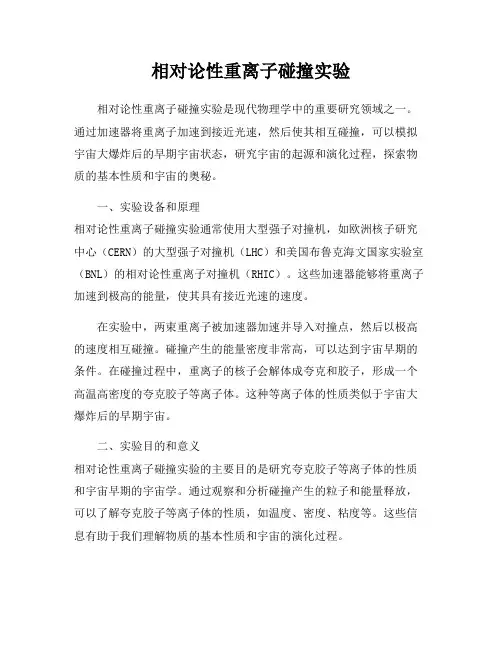
相对论性重离子碰撞实验相对论性重离子碰撞实验是现代物理学中的重要研究领域之一。
通过加速器将重离子加速到接近光速,然后使其相互碰撞,可以模拟宇宙大爆炸后的早期宇宙状态,研究宇宙的起源和演化过程,探索物质的基本性质和宇宙的奥秘。
一、实验设备和原理相对论性重离子碰撞实验通常使用大型强子对撞机,如欧洲核子研究中心(CERN)的大型强子对撞机(LHC)和美国布鲁克海文国家实验室(BNL)的相对论性重离子对撞机(RHIC)。
这些加速器能够将重离子加速到极高的能量,使其具有接近光速的速度。
在实验中,两束重离子被加速器加速并导入对撞点,然后以极高的速度相互碰撞。
碰撞产生的能量密度非常高,可以达到宇宙早期的条件。
在碰撞过程中,重离子的核子会解体成夸克和胶子,形成一个高温高密度的夸克胶子等离子体。
这种等离子体的性质类似于宇宙大爆炸后的早期宇宙。
二、实验目的和意义相对论性重离子碰撞实验的主要目的是研究夸克胶子等离子体的性质和宇宙早期的宇宙学。
通过观察和分析碰撞产生的粒子和能量释放,可以了解夸克胶子等离子体的性质,如温度、密度、粘度等。
这些信息有助于我们理解物质的基本性质和宇宙的演化过程。
相对论性重离子碰撞实验还可以研究夸克胶子等离子体的相变过程。
当温度和密度达到一定的临界值时,夸克胶子等离子体会发生相变,从而产生强子。
通过观察和分析相变过程,可以研究物质的相变性质和相变机制。
此外,相对论性重离子碰撞实验还可以研究强子物质的性质和强子之间的相互作用。
通过观察和分析碰撞产生的强子,可以了解强子的结构和性质,如质量、自旋、衰变等。
这对于我们理解强子物质的本质和强子之间的相互作用有重要意义。
三、实验结果和进展相对论性重离子碰撞实验已经取得了许多重要的科学成果。
例如,LHC 在2012年发现了希格斯玻色子,这是标准模型中最后一个被实验证实的粒子。
这一发现对于我们理解基本粒子的质量来源和宇宙的演化具有重要意义。
此外,相对论性重离子碰撞实验还观察到了夸克胶子等离子体的流体性质。
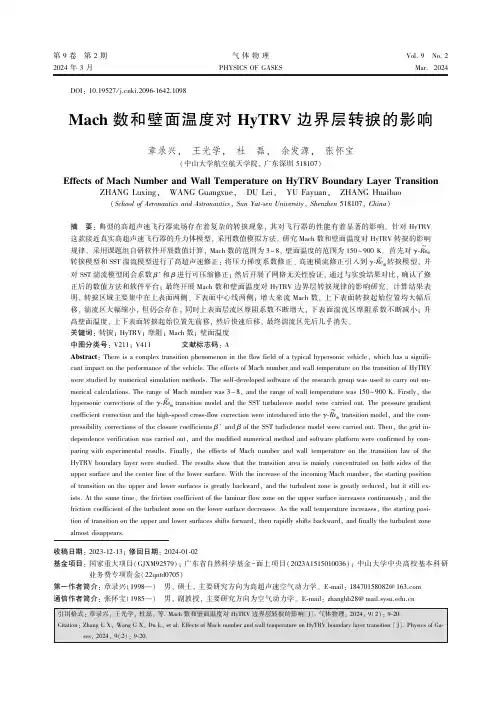
第9卷㊀第2期2024年3月气体物理PHYSICSOFGASESVol.9㊀No.2Mar.2024㊀㊀DOI:10.19527/j.cnki.2096 ̄1642.1098Mach数和壁面温度对HyTRV边界层转捩的影响章录兴ꎬ㊀王光学ꎬ㊀杜㊀磊ꎬ㊀余发源ꎬ㊀张怀宝(中山大学航空航天学院ꎬ广东深圳518107)EffectsofMachNumberandWallTemperatureonHyTRVBoundaryLayerTransitionZHANGLuxingꎬ㊀WANGGuangxueꎬ㊀DULeiꎬ㊀YUFayuanꎬ㊀ZHANGHuaibao(SchoolofAeronauticsandAstronauticsꎬSunYat ̄senUniversityꎬShenzhen518107ꎬChina)摘㊀要:典型的高超声速飞行器流场存在着复杂的转捩现象ꎬ其对飞行器的性能有着显著的影响ꎮ针对HyTRV这款接近真实高超声速飞行器的升力体模型ꎬ采用数值模拟方法ꎬ研究Mach数和壁面温度对HyTRV转捩的影响规律ꎮ采用课题组自研软件开展数值计算ꎬMach数的范围为3~8ꎬ壁面温度的范围为150~900Kꎮ首先对γ ̄Re~θt转捩模型和SST湍流模型进行了高超声速修正:将压力梯度系数修正㊁高速横流修正引入到γ ̄Re~θt转捩模型ꎬ并对SST湍流模型闭合系数β∗和β进行可压缩修正ꎻ然后开展了网格无关性验证ꎬ通过与实验结果对比ꎬ确认了修正后的数值方法和软件平台ꎻ最终开展Mach数和壁面温度对HyTRV边界层转捩规律的影响研究ꎮ计算结果表明ꎬ转捩区域主要集中在上表面两侧㊁下表面中心线两侧ꎻ增大来流Mach数ꎬ上下表面转捩起始位置均大幅后移ꎬ湍流区大幅缩小ꎬ但仍会存在ꎬ同时上表面层流区摩阻系数不断增大ꎬ下表面湍流区摩阻系数不断减小ꎻ升高壁面温度ꎬ上下表面转捩起始位置先前移ꎬ然后快速后移ꎬ最终湍流区先后几乎消失ꎮ关键词:转捩ꎻHyTRVꎻ摩阻ꎻMach数ꎻ壁面温度㊀㊀㊀收稿日期:2023 ̄12 ̄13ꎻ修回日期:2024 ̄01 ̄02基金项目:国家重大项目(GJXM92579)ꎻ广东省自然科学基金-面上项目(2023A1515010036)ꎻ中山大学中央高校基本科研业务费专项资金(22qntd0705)第一作者简介:章录兴(1998 )㊀男ꎬ硕士ꎬ主要研究方向为高超声速空气动力学ꎮE ̄mail:184****8082@163.com通信作者简介:张怀宝(1985 )㊀男ꎬ副教授ꎬ主要研究方向为空气动力学ꎮE ̄mail:zhanghb28@mail.sysu.edu.cn中图分类号:V211ꎻV411㊀㊀文献标志码:AAbstract:Thereisacomplextransitionphenomenonintheflowfieldofatypicalhypersonicvehicleꎬwhichhasasignifi ̄cantimpactontheperformanceofthevehicle.TheeffectsofMachnumberandwalltemperatureonthetransitionofHyTRVwerestudiedbynumericalsimulationmethods.Theself ̄developedsoftwareoftheresearchgroupwasusedtocarryoutnu ̄mericalcalculations.TherangeofMachnumberwas3~8ꎬandtherangeofwalltemperaturewas150~900K.Firstlyꎬthehypersoniccorrectionsoftheγ ̄Re~θttransitionmodelandtheSSTturbulencemodelwerecarriedout.Thepressuregradientcoefficientcorrectionandthehigh ̄speedcross ̄flowcorrectionwereintroducedintotheγ ̄Re~θttransitionmodelꎬandthecom ̄pressibilitycorrectionsoftheclosurecoefficientsβ∗andβoftheSSTturbulencemodelwerecarriedout.Thenꎬthegridin ̄dependenceverificationwascarriedoutꎬandthemodifiednumericalmethodandsoftwareplatformwereconfirmedbycom ̄paringwithexperimentalresults.FinallyꎬtheeffectsofMachnumberandwalltemperatureonthetransitionlawoftheHyTRVboundarylayerwerestudied.Theresultsshowthatthetransitionareaismainlyconcentratedonbothsidesoftheuppersurfaceandthecenterlineofthelowersurface.WiththeincreaseoftheincomingMachnumberꎬthestartingpositionoftransitionontheupperandlowersurfacesisgreatlybackwardꎬandtheturbulentzoneisgreatlyreducedꎬbutitstillex ̄ists.Atthesametimeꎬthefrictioncoefficientofthelaminarflowzoneontheuppersurfaceincreasescontinuouslyꎬandthefrictioncoefficientoftheturbulentzoneonthelowersurfacedecreases.Asthewalltemperatureincreasesꎬthestartingposi ̄tionoftransitionontheupperandlowersurfacesshiftsforwardꎬthenrapidlyshiftsbackwardꎬandfinallytheturbulentzonealmostdisappears.气体物理2024年㊀第9卷Keywords:transitionꎻHyTRVꎻfrictionꎻMachnumberꎻwalltemperature引㊀言高超声速飞行器具有突防能力强㊁打击范围广㊁响应迅速等显著优势ꎬ正逐渐成为各国空天竞争的热点[1]ꎮ高超声速飞行器边界层转捩是该类飞行器气动设计中的重要问题[2]ꎮ在边界层转捩过程中ꎬ流态由层流转变为湍流ꎬ飞行器的表面摩阻急剧增大到层流时的3~5倍ꎬ严重影响飞行器的气动性能与热防护系统ꎬ转捩还会导致飞行器壁面烧蚀㊁颤振加剧㊁飞行姿态控制难度大等一系列问题ꎬ对飞行器的飞行安全构成严重的威胁[3 ̄5]ꎬ开展高超声速飞行器边界层转捩研究具有十分重要的意义ꎮ影响边界层转捩的因素很多ꎬ例如ꎬMach数㊁Reynolds数㊁湍流强度㊁表面传导热等ꎮ在高超声速流动条件下ꎬ强激波㊁强逆压梯度㊁熵层等高超声速现象及其相互作用ꎬ会使得转捩流动的预测和研究难度进一步增大[6]ꎮ目前高超声速飞行器转捩数值模拟方法主要有直接数值模拟(DNS)㊁大涡模拟(LES)和基于Reynolds平均Navier ̄Stokes(RANS)的转捩模型方法ꎬ由于前两种计算量巨大ꎬ难以推广到工程应用ꎬ基于Reynolds平均Navier ̄Stokes的转捩模型在工程实践中应用最为广泛ꎬ其中γ ̄Re~θt转捩模型基于局部变量ꎬ与现代CFD方法良好兼容ꎬ目前已经有多项研究尝试从一般性的流动问题拓展到高超声速流动转捩模拟[6 ̄9]ꎮ目前高超声速流动转捩的研究对象主要是结构相对简单的构型ꎮMcDaniel等[10]研究了扩口直锥在高超声速流动条件下的转捩现象ꎮPapp等[11]研究了圆锥在高超声速流动条件下的转捩特性ꎮ美国和澳大利亚组织联合实施的HIFiRE计划[12]ꎬ研究了圆锥形状的HIFiRE1和椭圆锥形的HIFiRE5的转捩问题ꎮ杨云军等[13]采用数值模拟方法ꎬ分析了椭圆锥的转捩影响机制ꎬ并研究了Reynolds数对转捩特性的影响规律ꎮ另外ꎬ袁先旭等[14]于2015年成功实施了圆锥体MF ̄1航天模型飞行试验ꎮ以上对高超声速流动的转捩研究ꎬ都取得了比较理想的结果ꎬ然而所采用的模型都是圆锥㊁椭圆锥等简单几何外形ꎬ这与真实高超声速飞行器有较大差异ꎬ较难反映真实的转捩特性ꎮ为了有效促进对真实高超声速飞行器的转捩问题研究ꎬ中国空气动力研究与发展中心提出并设计了一款接近真实飞行器的升力体模型ꎬ即高超声速转捩研究飞行器(hypersonictransitionresearchvehicleꎬHyTRV)[15]ꎬ模型详细的参数见参考文献[16]ꎮHyTRV外形如图1所示ꎬ其整体外形较为复杂ꎬ不同区域发生转捩的情况也不尽相同ꎮ对HyTRV的转捩问题研究能够显著提高对真实高超声速飞行器转捩特性的认识水平ꎮLiu等[17]采用理论分析㊁数值模拟和风洞实验3种方法对HyTRV的转捩特性进行了研究ꎻ陈坚强等[15]分析了HyTRV的边界层失稳特征ꎻChen等[18]对HyTRV进行了多维线性稳定性分析ꎻQi等[19]在来流Mach数6㊁攻角0ʎ的条件下对HyTRV进行了直接数值模拟ꎻ万兵兵等[20]结合风洞实验与飞行试验ꎬ利用eN方法预测了HyTRV升力体横流区的转捩阵面形状ꎮ目前ꎬ相关研究主要集中在HyTRV的稳定性特征及转捩预测两个方面ꎬ而对若干关键参数ꎬ特别是Mach数和壁面温度对转捩的影响研究还比较少ꎮ(a)Frontview(b)Sideview㊀㊀㊀图1㊀HyTRV外形Fig.1㊀ShapeofHyTRV基于此ꎬ本文采用数值模拟方法ꎬ应用课题组自研软件开展Mach数和壁面温度对HyTRV转捩流动的影响规律研究ꎮ1㊀数值方法1.1㊀控制方程和数值方法控制方程为三维可压缩RANS方程ꎬ采用结构网格技术和有限体积方法ꎬ变量插值方法采用2阶MUSCL格式ꎬ通量计算采用低耗散的通量向量差分Roe格式ꎬ黏性项离散采用中心格式ꎬ时间推进方法采用LU ̄SGS格式ꎮ壁面采用等温㊁无滑移壁面条件ꎬ入口采用Riemann远场边界条件ꎬ出口采用零梯度外推边界条件ꎮ1.2㊀γ ̄Re~θt转捩模型γ ̄Re~θt转捩模型是Menter等[21ꎬ22]于2004年提01第2期章录兴ꎬ等:Mach数和壁面温度对HyTRV边界层转捩的影响出的一种基于拟合公式的间歇因子转捩模型ꎬ在2009年公布了完整的拟合公式及相关参数[23]ꎮ许多学者也开发了相应的程序ꎬ并进行了大量的算例验证[24 ̄28]ꎬ证明了该模型具有较好的转捩预测能力ꎬ预测精度较高ꎻ通过合适的标定ꎬγ ̄Re~θt转捩模型可以适用于多种情况下的转捩模拟ꎮ该模型构建了关于间歇因子γ的输运方程和关于转捩动量厚度Reynolds数Re~θt的输运方程ꎮ具体来说ꎬγ表示该位置是湍流流动的概率ꎬ取值范围为0<γ<1ꎮ关于γ的控制方程为Ə(ργ)Ət+Ə(ρujγ)Əxj=Pγ-Eγ+ƏƏxjμ+μtσfæèçöø÷ƏγƏxjéëêêùûúú其中ꎬPγ为生成项ꎬEγ为破坏项ꎮ关于Re~θt的输运方程为Ə(ρRe~θt)Ət+Ə(ρujRe~θt)Əxj=Pθt+ƏƏxjσθt(μ+μt)ƏRe~θtƏxjéëêêùûúú其中ꎬPθt为源项ꎬ其作用是使边界层外部的Re~θt等于Reθtꎬ定义式为Pθt=cθtρt(Reθt-Re~θt)(1.0-Fθt)Reθt采用以下经验公式Reθt=1173.51-589 428Tu+0.2196Tu2æèçöø÷F(λθ)ꎬTuɤ0.3Reθt=331.50(Tu-0.5658)-0.671F(λθ)ꎬTu>0.3ìîíïïïïF(λθ)=1+(12.986λθ+123.66λ2θ+405.689λ3θ)e-(Tu1.5)1.5ꎬ㊀λθɤ0F(λθ)=1+0.275(1-e-35.0λθ)e-(Tu0.5)ꎬλθ>0ìîíïïïï在实际计算中ꎬ通过γ ̄Re~θt转捩模型获得间歇因子ꎬ再通过间歇因子来控制SSTk ̄ω湍流模型中湍动能的生成ꎮγ ̄Re~θt转捩模型与SSTk ̄ω湍流模型耦合为Ə(ρk)Ət+Ə(ρujk)Əxj=γeffτijƏuiƏxj-min(max(γeffꎬ0.1)ꎬ1.0)ρβ∗kω+ƏƏxjμ+μtσkæèçöø÷ƏkƏxjéëêêùûúúƏ(ρω)Ət+Ə(ρujω)Əxj=γvtτijƏuiƏxj-βρω2+ƏƏxj(μ+σωμt)ƏωƏxjéëêêùûúú+2ρ(1-F1)σω21ωƏkƏxjƏωƏxj模型中具体参数定义见文献[23]ꎮ1.3㊀高超声速修正原始SST湍流模型及γ ̄Re~θt转捩模型都是基于不可压缩流动发展的ꎬ为了更好地预测高超声速流动转捩ꎬ本节引入了3种重要的高超声速修正方法ꎮ1.3.1㊀压力梯度修正压力梯度对边界层转捩的影响较大ꎬ在高Mach数情况下ꎬ边界层厚度较大ꎬ进而影响压力梯度的大小ꎬ因此在模拟高超声速流动时应该考虑Mach数对压力梯度的影响ꎮ本文采用张毅峰等[29]提出的压力梯度修正方法ꎬ具体修正形式如下λᶄθ=λθ1+γᶄ-12Maeæèçöø÷其中ꎬMae为边界层外缘Mach数ꎬγᶄ为比热比ꎮ1.3.2㊀高速横流修正在原始γ ̄Re~θt转捩模型中ꎬ没有考虑横流不稳定性对转捩的影响ꎬ对于横流模态主导的转捩ꎬ原始转捩模型计算的结果并不理想ꎮLangtry等[30]在2015年对γ ̄Re~θt转捩模型进行了低速横流修正ꎬ向星皓等[9]在Langtry低速横流修正的基础上ꎬ对高超声速椭圆锥转捩DNS数据进行了拓展ꎬ提出了高速横流转捩判据ꎬ本文直接采用向星皓提出的高速横流转捩方法ꎮLangtry将横流强度引入转捩发生动量厚度Reynolds数输运方程中Ə(ρRe~θt)Ət+Ə(ρujRe~θt)Əxj=Pθt+DSCF+ƏƏxjσθt(μ+μt)ƏRe~θtƏxjéëêêùûúú式中ꎬDSCF为横流源项ꎬLangtry低速横流修正为DSCF=cθtρtccrossflowmin(ReSCF-Re~θtꎬ0.0)Fθt2其中ꎬReSCF为低速横流判据ReSCF=θtρUlocal0.82æèçöø÷μ=-35.088lnhθtæèçöø÷+319.51+f(+ΔHcrossflow)-f(-ΔHcrossflow)其中ꎬh为壁面粗糙度高度ꎬθt为动量厚度ꎬ11气体物理2024年㊀第9卷ΔHcrossflow是横流强度抬升项ꎮ向星皓提出的高速横流转捩判据ꎬ其中高速横流源项DSCF ̄H为DSCF ̄H=cCFρmin(ReSCF ̄H-Re~θtꎬ0)FθtReSCF ̄H=CCF ̄1lnhlμ+CCF ̄2+(Hcrossflow)其中ꎬCCF ̄1=-9.618ꎬCCF ̄2=128.33ꎻlμ为粗糙度参考高度ꎬlμ=1μmꎻf(Hcrossflow)为抬升函数f(Hcrossflow)=60000.1066-ΔHcrossflow+50000(0.1066-ΔHcrossflow)2其中ꎬΔHcrossflow与Langtry低速横流修正中保持一致ꎮ1.3.3㊀SST可压缩修正高超声速流动具有强可压缩性ꎬ所以在进行高超声速计算时ꎬ应该对湍流模型进行可压缩修正ꎮSarkar[31]提出了膨胀耗散修正ꎬ对SST湍流模型中的闭合系数β∗ꎬβ进行了可压缩修正ꎬWilcox[32]在Sarkar修正的基础上考虑了可压缩生成项产生时的延迟效应ꎬ使得可压缩修正在湍流Mach数较小的近壁面关闭ꎬ在湍流Mach数较大的自由剪切层打开ꎬ本文采用Wilcox提出的可压缩性修正β∗=β∗0[1+ξ∗F(Mat)]β=β0-β∗0ξ∗F(Mat)其中ꎬβ0ꎬβ∗均为原始模型中的系数ꎬξ∗=1.5ꎮF(Mat)=[Mat-Mat0]H(Mat-Mat0)Mat0=1/4ꎬH(x)=0ꎬxɤ01ꎬx>0{其中ꎬMat=2k/a为湍流Mach数ꎬa为当地声速ꎮ2㊀网格无关性验证及数值方法确认2.1㊀网格无关性验证计算采用3套网格ꎬ考虑到HyTRV的几何对称性ꎬ生成3套半模网格ꎬ第1层网格高度为1ˑ10-6mꎬ确保y+<1ꎬ流向ˑ法向ˑ周向的网格数分别为:网格1是301ˑ201ˑ201ꎬ网格2是301ˑ301ˑ201ꎬ网格3是401ˑ381ˑ281ꎮ全模下表面如图2所示ꎬ选取y/L=0中心线和x/L=0.5处ꎬ对比3套网格的表面摩阻系数ꎬ计算结果如图3所示ꎮ采用网格1时ꎬ表面摩阻系数分布与另外两个结果存在明显差异ꎻ而采用网格2和网格3时ꎬ表面摩阻系数曲线基本重合ꎬ表明在流向㊁法向和周向均满足网格无关性ꎬ后续数值计算采用网格2ꎮ图2㊀截取位置示意图Fig.2㊀Schematicdiagramoftheinterceptionlocation(a)Surfacefrictionaty/L=0(b)Surfacefrictionatx/L=0.5图3㊀采用3套网格计算得到的摩阻对比Fig.3㊀Comparisonofthefrictiondragcalculatedusingthreesetsofgrids2.2㊀数值方法和自研软件的确认采用修正后的转捩模型对HyTRV开展计算ꎬ计算工况为Ma=6ꎬ来流温度Tɕ=97Kꎬ单位21第2期章录兴ꎬ等:Mach数和壁面温度对HyTRV边界层转捩的影响Reynolds数为Re=1.1ˑ107/mꎬ攻角α=0ʎꎬ来流湍流度FSTI=0.8%ꎬ壁面温度T=300Kꎮ为方便对比分析ꎬ计算结果与参考结果均采用上下对称形式布置ꎬ例如ꎬ图4是模型下表面计算结果与实验结果对比:对于下表面两侧转捩的起始位置ꎬ高超声速修正前的转捩位置在x=0.68m附近ꎬ高超声速修正后的计算结果与实验结果吻合良好ꎬ均在x=0.60m附近ꎬ并且湍流边界层区域形状基本一致ꎬ说明修正后的转捩模型能够较好地预测HyTRV转捩的位置ꎮ(a)Calculationofthefrictiondistribution(beforehypersoniccorrection)(b)Calculationofthefrictiondistribution(afterhypersoniccorrection)(c)Experimentalresultsoftheheatfluxdistribution[17]图4㊀下表面计算结果和实验结果对比Fig.4㊀Comparisonofthecalculatedandexperimentalresultsonthelowersurface3㊀HyTRV转捩的基本流动特性计算工况采用Ma=6ꎬ攻角α=0ʎꎬ来流湍流度FSTI=0.6%ꎬ分析HyTRV转捩的基本流动特性ꎮ从图5可以看出ꎬ模型两侧和顶端均出现高压区ꎬ高压区之间为低压区ꎬ横截面上存在周向压力梯度ꎬ流动从高压区向低压区汇集ꎬ从而在下表面中心线附近和上表面两侧腰部区域均形成流向涡结构(见图6)ꎬ沿流动方向ꎬ高压区域逐渐扩大ꎬ流向涡结构的影响范围也越大ꎮ在流向涡结构的边缘位置ꎬ壁面附近的低速流体被抬升到外壁面区域ꎬ外壁面区域的高速流体又被带入到近壁面区域ꎬ进而导致流向涡结构边缘处壁面的摩阻显著增加ꎬ最终诱发转捩ꎬ这些流动特征与文献[15]的结果一致ꎮ图7显示了上下表面摩阻的分布情况ꎬ其中上表面两侧区域在x/L=0.80附近ꎬ摩阻显著增加ꎬ出现明显的转捩现象ꎬ转捩区域分布在两侧边缘位置ꎻ而下表面两侧区域在x/L=0.75附近ꎬ也出现明显的转捩ꎬ转捩区域相对集中在中心线两侧ꎮ图5㊀不同截面位置处的压力云图Fig.5㊀Pressurecontoursatdifferentcross ̄sectionlocations图6㊀不同截面位置处的流向速度云图Fig.6㊀Streamwisevelocitycontoursatdifferentcross ̄sectionlocations31气体物理2024年㊀第9卷(a)Uppersurface㊀㊀㊀㊀㊀(b)Lowersurface图7㊀上下表面摩阻分布云图Fig.7㊀Frictioncoefficientcontoursontheupperandlowersurfaces4㊀不同Mach数对HyTRV转捩的影响保持来流湍流度FSTI=0.6%不变ꎬMach数变化范围为3~8ꎮ图8是不同Mach数条件下HyTRV上下表面的摩阻分布云图ꎬ从图中可知ꎬ随着Mach数的增加ꎬ上下表面的湍流区域均逐渐减少ꎬ其中上表面两侧转捩起始位置由x/L=0.56附近后移至x/L=0.92附近ꎬ下表面两侧转捩起始位置由x/L=0.48附近后移至x/L=0.99附近ꎬ上下表面两侧转捩起始位置均大幅后移ꎬ说明Mach数对HyTRV转捩的影响很大ꎮuppersurface㊀㊀㊀㊀㊀㊀㊀㊀㊀㊀㊀㊀㊀㊀㊀㊀lowersurface(a)Ma=3uppersurface㊀㊀㊀㊀㊀㊀㊀㊀㊀㊀㊀㊀㊀㊀㊀㊀lowersurface(b)Ma=4uppersurface㊀㊀㊀㊀㊀㊀㊀㊀㊀㊀㊀㊀㊀㊀㊀㊀lowersurface(c)Ma=541第2期章录兴ꎬ等:Mach数和壁面温度对HyTRV边界层转捩的影响uppersurface㊀㊀㊀㊀㊀㊀㊀㊀㊀㊀㊀㊀㊀㊀㊀㊀lowersurface(d)Ma=6uppersurface㊀㊀㊀㊀㊀㊀㊀㊀㊀㊀㊀㊀㊀㊀㊀㊀lowersurface(e)Ma=7uppersurface㊀㊀㊀㊀㊀㊀㊀㊀㊀㊀㊀㊀㊀㊀㊀㊀lowersurface(f)Ma=8图8㊀不同Mach数条件下摩阻系数分布云图Fig.8㊀FrictioncoefficientcontoursatdifferentMachnumbers上表面选取图7中z/L=0.12的位置ꎬ下表面选取z/L=0.10的位置进行分析ꎮ从图9中可以分析出ꎬ随着Mach数的增加ꎬ上表面转捩起始位置不断后移ꎬ当Mach数增加到7时ꎬ由于湍流区的缩小ꎬ此处位置不再发生转捩ꎬ此外ꎬMach数越高层流区摩阻系数越大ꎻ下表面转捩起始位置也不断后移ꎬ当Mach数增加到8时ꎬ此处位置不再发生转捩ꎬ此外ꎬMach数越高ꎬ湍流区的摩阻系数越小ꎬ这些结论与关于来流Mach数对转捩位置影响的普遍研究结论一致ꎮ(a)Uppersurface㊀㊀㊀㊀㊀(b)Lowersurface图9㊀不同位置摩阻系数随Mach数的变化Fig.9㊀VariationoffrictioncoefficientwithMachnumberatdifferentlocations51气体物理2024年㊀第9卷5㊀不同壁面温度对HyTRV转捩的影响保持来流湍流度FSTI=0.6%及Ma=6不变ꎬ壁面温度的变化范围为150~900Kꎮ图10是不同壁面温度条件下HyTRV上下表面的摩阻分布云图ꎬ可以看出随着壁面温度的增加ꎬ上表面两侧湍流区域先是缓慢扩大ꎬ在壁面温度为500K时湍流区域快速缩小ꎬ增加到900K时ꎬ已无明显湍流区域ꎻ下表面两侧湍流区域先是无明显变化ꎬ同样当壁面温度升高到500K时ꎬ湍流区域快速缩小ꎬ当壁面温度升高到700K时ꎬ两侧已经无明显的湍流区域ꎬ相比上表面两侧湍流区域ꎬ下表面湍流区域消失得更早ꎮ由此可以得出壁面温度对转捩的产生有较大的影响ꎬ壁面温度增加到一定程度将导致HyTRV没有明显的转捩现象ꎮuppersurface㊀㊀㊀㊀㊀㊀㊀㊀㊀㊀㊀㊀㊀㊀㊀㊀lowersurface(a)T=150Kuppersurface㊀㊀㊀㊀㊀㊀㊀㊀㊀㊀㊀㊀㊀㊀㊀㊀lowersurface(b)T=200Kuppersurface㊀㊀㊀㊀㊀㊀㊀㊀㊀㊀㊀㊀㊀㊀㊀㊀lowersurface(c)T=300Kuppersurface㊀㊀㊀㊀㊀㊀㊀㊀㊀㊀㊀㊀㊀㊀㊀㊀lowersurface(d)T=500K61第2期章录兴ꎬ等:Mach数和壁面温度对HyTRV边界层转捩的影响uppersurface㊀㊀㊀㊀㊀㊀㊀㊀㊀㊀㊀㊀㊀㊀㊀㊀lowersurface(e)T=700Kuppersurface㊀㊀㊀㊀㊀㊀㊀㊀㊀㊀㊀㊀㊀㊀㊀㊀lowersurface(f)T=900K图10㊀不同壁面温度条件下摩阻系数分布云图Fig.10㊀Frictioncoefficientcontoursatdifferentwalltemperatureconditions上表面选取z/L=0.125的位置ꎬ下表面选取z/L=0.100的位置进行分析ꎮ从图11中可以分析出ꎬ随着壁面温度的增加ꎬ上表面转捩起始位置先前移ꎬ当壁面温度增加到500K时ꎬ转捩起始位置后移ꎬ转捩区长度逐渐增加ꎬ层流区域的摩阻系数逐渐增加ꎬ当壁面温度增加到700K时ꎬ该位置已不再出现转捩ꎻ下表面转捩起始位置先小幅后移ꎬ当壁面温度增加到300K时ꎬ转捩起始位置开始后移ꎬ当壁面温度增加到700K时ꎬ由于湍流区域的减小ꎬ该位置不再发生转捩ꎮ(a)Uppersurface㊀㊀㊀㊀㊀(b)Lowersurface图11㊀不同位置摩阻系数随壁面温度的变化Fig.11㊀Variationoffrictioncoefficientwithwalltemperatureatdifferentlocations为进一步分析壁面温度的影响ꎬ本文分别在上下表面湍流区选取一点(0.9ꎬ0.029ꎬ0.14)ꎬ(0.97ꎬ-0.34ꎬ0.12)ꎬ分析边界层湍动能剖面ꎬ结果如图12所示ꎮ从图中可以看到ꎬ随着壁面温度升高ꎬ边界层厚度先略微变厚ꎬ再变薄ꎬ当壁面温度升高到700K时ꎬ边界层厚度迅速降低ꎮ这些结果与转捩位置先前移再后移的结论相符合ꎬ因为边界层厚度会影响不稳定波的时间和空间尺度ꎬ边界层厚度低时ꎬ不稳定波增长速度变慢ꎬ延迟转捩发生ꎮ需要指出的是ꎬ仅采用当前使用的方法ꎬ无法从更深层71气体物理2024年㊀第9卷次揭示转捩反转的流动机理ꎬ而须另外借助稳定性分析方法ꎬ例如ꎬ使用eN方法开展基于模态的稳定性研究ꎮ文献[33]采用该手段研究了大掠角平板钝三角翼随壁温比变化出现转捩反转的内在机理:壁温比升高促进横流模态和第1模态扰动增长ꎬ抑制第2模态发展ꎬ在第1㊁2模态联合作用影响下ꎬ出现转捩反转现象ꎮ我们将在后续开展进一步研究ꎮ(a)Uppersurface(b)Lowersurface图12㊀不同位置湍动能剖面随壁面温度的变化Fig.12㊀Variationofturbulentkineticenergywithwalltemperatureatdifferentlocations6㊀结论针对HyTRV转捩问题ꎬ在Mach数Ma=3~8ꎬ壁面温度T=150~900K的条件下ꎬ基于课题组自研软件ꎬ对γ ̄Re~θt转捩模型和SST湍流模型进行了高超声速修正ꎬ研究了Mach数和壁面温度对HyTRV转捩的影响ꎬ得出以下结论:1)经过高超声速修正后的γ ̄Re~θt转捩模型和SST湍流模型能够较为准确地预测HyTRV转捩位置ꎬ并且湍流边界层区域形状与实验结果基本一致ꎻHyTRV存在多个不同的转捩区域ꎬ上表面两侧转捩区域分布在两侧边缘位置ꎬ下表面两侧转捩区域分布在中心线两侧ꎮ2)Mach数的增加会导致上下表面转捩起始位置均大幅后移ꎬ湍流区大幅缩小ꎬ但当Mach数增加到8时ꎬ湍流区仍然存在ꎬ并没有消失ꎻ上表面层流区摩阻不断增加ꎬ下表面湍流区摩阻不断减小ꎮ3)壁面温度的增加会导致上下表面转捩起始位置先前移ꎬ再后移ꎬ这与边界层厚度变化规律一致ꎬ当壁面温度增加到700K时ꎬ下表面湍流区已经基本消失ꎬ当壁面温度增加到900K时ꎬ上表面湍流区也基本消失ꎻ上表面在层流区域的摩阻系数逐渐增大ꎬ在湍流区的摩阻系数逐渐减小ꎮ致谢㊀感谢中国空气动力研究与发展中心和空天飞行空气动力科学与技术全国重点实验室提供的HyTRV模型数据和实验数据ꎮ参考文献(References)[1]㊀OberingIIIHꎬHeinrichsRL.Missiledefenseforgreatpowerconflict:outmaneuveringtheChinathreat[J].Stra ̄tegicStudiesQuarterlyꎬ2019ꎬ3(4):37 ̄56. [2]ChengCꎬWuJHꎬZhangYLꎬetal.Aerodynamicsanddynamicstabilityofmicro ̄air ̄vehiclewithfourflappingwingsinhoveringflight[J].AdvancesinAerodynamicsꎬ2020ꎬ2(3):5.[3]BertinJJꎬCummingsRM.Fiftyyearsofhypersonics:whereweᶄvebeenꎬwhereweᶄregoing[J].ProgressinAerospaceSciencesꎬ2003ꎬ39(6/7):511 ̄536. [4]陈坚强ꎬ涂国华ꎬ张毅锋ꎬ等.高超声速边界层转捩研究现状与发展趋势[J].空气动力学学报ꎬ2017ꎬ35(3):311 ̄337.ChenJQꎬTuGHꎬZhangYFꎬetal.Hypersnonicboundarylayertransition:whatweknowꎬwhereshallwego[J].ActaAerodynamicaSinicaꎬ2017ꎬ35(3):311 ̄337(inChinese).[5]段毅ꎬ姚世勇ꎬ李思怡ꎬ等.高超声速边界层转捩的若干问题及工程应用研究进展综述[J].空气动力学学报ꎬ2020ꎬ38(2):391 ̄403.DuanYꎬYaoSYꎬLiSYꎬetal.Reviewofprogressinsomeissuesandengineeringapplicationofhypersonicboundarylayertransition[J].ActaAerodynamicaSinicaꎬ2020ꎬ38(2):391 ̄403(inChinese).[6]ZhangYFꎬZhangYRꎬChenJQꎬetal.Numericalsi ̄81第2期章录兴ꎬ等:Mach数和壁面温度对HyTRV边界层转捩的影响mulationsofhypersonicboundarylayertransitionbasedontheflowsolverchant2.0[R].AIAA2017 ̄2409ꎬ2017. [7]KrauseMꎬBehrMꎬBallmannJ.Modelingoftransitioneffectsinhypersonicintakeflowsusingacorrelation ̄basedintermittencymodel[R].AIAA2008 ̄2598ꎬ2008. [8]YiMRꎬZhaoHYꎬLeJL.Hypersonicnaturalandforcedtransitionsimulationbycorrelation ̄basedintermit ̄tency[R].AIAA2017 ̄2337ꎬ2017.[9]向星皓ꎬ张毅锋ꎬ袁先旭ꎬ等.C ̄γ ̄Reθ高超声速三维边界层转捩预测模型[J].航空学报ꎬ2021ꎬ42(9):625711.XiangXHꎬZhangYFꎬYuanXXꎬetal.C ̄γ ̄Reθmodelforhypersonicthree ̄dimensionalboundarylayertransitionprediction[J].ActaAeronauticaetAstronauticaSinicaꎬ2021ꎬ42(9):625711(inChinese).[10]McDanielRDꎬNanceRPꎬHassanHA.Transitiononsetpredictionforhigh ̄speedflow[J].JournalofSpacecraftandRocketsꎬ2000ꎬ37(3):304 ̄309.[11]PappJLꎬDashSM.Rapidengineeringapproachtomodelinghypersoniclaminar ̄to ̄turbulenttransitionalflows[J].JournalofSpacecraftandRocketsꎬ2005ꎬ42(3):467 ̄475.[12]JulianoTJꎬSchneiderSP.InstabilityandtransitionontheHIFiRE ̄5inaMach ̄6quiettunnel[R].AIAA2010 ̄5004ꎬ2010.[13]杨云军ꎬ马汉东ꎬ周伟江.高超声速流动转捩的数值研究[J].宇航学报ꎬ2006ꎬ27(1):85 ̄88.YangYJꎬMaHDꎬZhouWJ.Numericalresearchonsupersonicflowtransition[J].JournalofAstronauticsꎬ2006ꎬ27(1):85 ̄88(inChinese).[14]袁先旭ꎬ何琨ꎬ陈坚强ꎬ等.MF ̄1模型飞行试验转捩结果初步分析[J].空气动力学学报ꎬ2018ꎬ36(2):286 ̄293.YuanXXꎬHeKꎬChenJQꎬetal.PreliminarytransitionresearchanalysisofMF ̄1[J].ActaAerodynamicaSinicaꎬ2018ꎬ36(2):286 ̄293(inChinese).[15]陈坚强ꎬ涂国华ꎬ万兵兵ꎬ等.HyTRV流场特征与边界层稳定性特征分析[J].航空学报ꎬ2021ꎬ42(6):124317.ChenJQꎬTuGHꎬWanBBꎬetal.Characteristicsofflowfieldandboundary ̄layerstabilityofHyTRV[J].ActaAeronauticaetAstronauticaSinicaꎬ2021ꎬ42(6):124317(inChinese).[16]陈坚强ꎬ刘深深ꎬ刘智勇ꎬ等.用于高超声速边界层转捩研究的标模气动布局及设计方法.中国:109969374B[P].2021 ̄05 ̄18.ChenJQꎬLiuSSꎬLiuZYꎬetal.Standardmodelaero ̄dynamiclayoutanddesignmethodforhypersonicboundarylayertransitionresearch.CNꎬ109969374B[P].2021 ̄05 ̄18(inChinese).[17]LiuSSꎬYuanXXꎬLiuZYꎬetal.Designandtransitioncharacteristicsofastandardmodelforhypersonicboundarylayertransitionresearch[J].ActaMechanicaSinicaꎬ2021ꎬ37(11):1637 ̄1647.[18]ChenXꎬDongSWꎬTuGHꎬetal.Boundarylayertran ̄sitionandlinearmodalinstabilitiesofhypersonicflowoveraliftingbody[J].JournalofFluidMechanicsꎬ2022ꎬ938(408):A8.[19]QiHꎬLiXLꎬYuCPꎬetal.Directnumericalsimulationofhypersonicboundarylayertransitionoveralifting ̄bodymodelHyTRV[J].AdvancesinAerodynamicsꎬ2021ꎬ3(1):31.[20]万兵兵ꎬ陈曦ꎬ陈坚强ꎬ等.三维边界层转捩预测HyTEN软件在高超声速典型标模中的应用[J].空天技术ꎬ2023(1):150 ̄158.WanBBꎬChenXꎬChenJQꎬetal.ApplicationsofHyTENsoftwareforpredictingthree ̄dimensionalboundary ̄layertransitionintypicalhypersonicmodels[J].AerospaceTechnologyꎬ2023(1):150 ̄158(inChinese). [21]MenterFRꎬLangtryRBꎬLikkiSRꎬetal.Acorrelation ̄basedtransitionmodelusinglocalvariables PartⅠ:modelformulation[J].JournalofTurbomachineryꎬ2006ꎬ128(3):413 ̄422.[22]LangtryRBꎬMenterFRꎬLikkiSRꎬetal.Acorrelation ̄basedtransitionmodelusinglocalvariables PartⅡ:testcasesandindustrialapplications[J].JournalofTur ̄bomachineryꎬ2006ꎬ128(3):423 ̄434.[23]LangtryRBꎬMenterFR.Correlation ̄basedtransitionmodelingforunstructuredparallelizedcomputationalfluiddynamicscodes[J].AIAAJournalꎬ2009ꎬ47(12):2894 ̄2906.[24]孟德虹ꎬ张玉伦ꎬ王光学ꎬ等.γ ̄Reθ转捩模型在二维低速问题中的应用[J].航空学报ꎬ2011ꎬ32(5):792 ̄801.MengDHꎬZhangYLꎬWangGXꎬetal.Applicationofγ ̄Reθtransitionmodeltotwo ̄dimensionallowspeedflows[J].ActaAeronauticaetAstronauticaSinicaꎬ2011ꎬ32(5):792 ̄801(inChinese).[25]牟斌ꎬ江雄ꎬ肖中云ꎬ等.γ ̄Reθ转捩模型的标定与应用[J].空气动力学学报ꎬ2013ꎬ31(1):103 ̄109.MouBꎬJiangXꎬXiaoZYꎬetal.Implementationandcaliberationofγ ̄Reθtransitionmodel[J].ActaAerody ̄namicaSinicaꎬ2013ꎬ31(1):103 ̄109(inChinese). [26]郭隽ꎬ刘丽平ꎬ徐晶磊ꎬ等.γ ̄Re~θt转捩模型在跨声速涡轮叶栅中的应用[J].推进技术ꎬ2018ꎬ39(9):1994 ̄2001.91气体物理2024年㊀第9卷GuoJꎬLiuLPꎬXuJLꎬetal.Applicationofγ ̄Re~θttran ̄sitionmodelintransonicturbinecascades[J].JournalofPropulsionTechnologyꎬ2018ꎬ39(9):1994 ̄2001(inChinese).[27]郑赟ꎬ李虹杨ꎬ刘大响.γ ̄Reθ转捩模型在高超声速下的应用及分析[J].推进技术ꎬ2014ꎬ35(3):296 ̄304.ZhengYꎬLiHYꎬLiuDX.Applicationandanalysisofγ ̄Reθtransitionmodelinhypersonicflow[J].JournalofPropulsionTechnologyꎬ2014ꎬ35(3):296 ̄304(inChi ̄nese).[28]孔维萱ꎬ阎超ꎬ赵瑞.γ ̄Reθ模式应用于高速边界层转捩的研究[J].空气动力学学报ꎬ2013ꎬ31(1):120 ̄126.KongWXꎬYanCꎬZhaoR.γ ̄Reθmodelresearchforhigh ̄speedboundarylayertransition[J].ActaAerody ̄namicaSinicaꎬ2013ꎬ31(1):120 ̄126(inChinese). [29]张毅锋ꎬ何琨ꎬ张益荣ꎬ等.Menter转捩模型在高超声速流动模拟中的改进及验证[J].宇航学报ꎬ2016ꎬ37(4):397 ̄402.ZhangYFꎬHeKꎬZhangYRꎬetal.ImprovementandvalidationofMenterᶄstransitionmodelforhypersonicflowsimulation[J].JournalofAstronauticsꎬ2016ꎬ37(4):397 ̄402(inChinese).[30]LangtryRBꎬSenguptaKꎬYehDTꎬetal.Extendingtheγ ̄Reθtcorrelationbasedtransitionmodelforcrossfloweffects(Invited)[R].AIAA2015 ̄2474ꎬ2015. [31]SarkarS.Thepressure ̄dilatationcorrelationincompressi ̄bleflows[J].PhysicsofFluidsAꎬ1992ꎬ4(12):2674 ̄2682.[32]WilcoxDC.Dilatation ̄dissipationcorrectionsforadvancedturbulencemodels[J].AIAAJournalꎬ1992ꎬ30(11):2639 ̄2646.[33]马祎蕾ꎬ余平ꎬ姚世勇.壁温对钝三角翼边界层稳定性及转捩影响[J].空气动力学学报ꎬ2020ꎬ38(6):1017 ̄1026.MaYLꎬYuPꎬYaoSY.Effectofwalltemperatureonstabilityandtransitionofhypersonicboundarylayeronabluntdeltawing[J].ActaAerodynamicaSinicaꎬ2020ꎬ38(6):1017 ̄1026(inChinese).02。
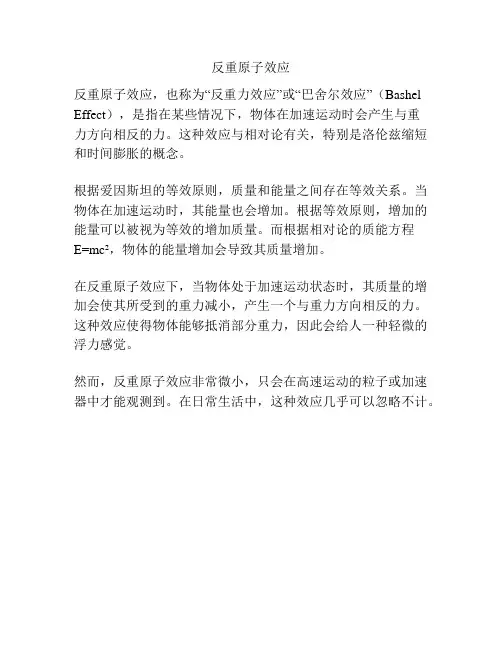
反重原子效应
反重原子效应,也称为“反重力效应”或“巴舍尔效应”(Bashel Effect),是指在某些情况下,物体在加速运动时会产生与重
力方向相反的力。
这种效应与相对论有关,特别是洛伦兹缩短和时间膨胀的概念。
根据爱因斯坦的等效原则,质量和能量之间存在等效关系。
当物体在加速运动时,其能量也会增加。
根据等效原则,增加的能量可以被视为等效的增加质量。
而根据相对论的质能方程
E=mc²,物体的能量增加会导致其质量增加。
在反重原子效应下,当物体处于加速运动状态时,其质量的增加会使其所受到的重力减小,产生一个与重力方向相反的力。
这种效应使得物体能够抵消部分重力,因此会给人一种轻微的浮力感觉。
然而,反重原子效应非常微小,只会在高速运动的粒子或加速器中才能观测到。
在日常生活中,这种效应几乎可以忽略不计。

物理与光电工程学院研究培养方案大连理工大学2012年6月目录物理学一级学科培养方案 (3)博士研究生 (3)学术型硕士研究生 (13)光学工程一级学培养方案 (31)博士研究生 (31)学术型硕士研究生 (15)全日制专业学位硕士 (37)电子科学与技术一级学科培养方案 (44)博士研究生 (49)学术型硕士研究生 (49)大连理工大学博士研究生培养方案物理学一级学科(一级学科(专业)代码:0702授予理学博士学位)一、培养目标本学科专业培养能够从事理论物理学、等离子体物理学、凝聚态物理学、光学,原子分子物理,生物物理学、神经信息学方面的教学、科研及管理工作的高层次人才。
学位获得者应具备坚实的物理理论基础和系统深入的专门知识;能熟练地运用一门外语进行专业学术交流;具备严谨的治学态度和刻苦钻研精神;具备独立从事科学研究工作的能力,并能够在科学或专门技术上取得创造性的成果。
二、学科群、专业及研究方向简介本学科点包括国家重点学科:等离子体物理;辽宁省重点学科:理论物理,等离子体物理。
2003年获得物理学一级学科博士学位授予权,设有物理学一级学科博士后流动站;•等离子体物理1998年获得博士授予权, 2001年被评为“国家重点学科”,2007年再次被评为国家重点学科;理论物理1986年获得硕士授予权,2000年获得博士授予权,2008年获批辽宁省重点建设学科。
本学科群依托教育部三束材料改性重点实验室和辽宁省先进光电技术重点实验室,设有理论物理研究所等十余个研究机构,拥有先进大型研究设备近百台(套),在“十一五”期间,共承担了各类课题100余项,包括国家自然科学基金重点项目,面上项目,青年基金项目,国际重大合作项目;“973”重点基础研究计划(课题)、国家重大研究计划ITER专项(课题),02专项(课题),“863”科技攻关项目;国防项目及预研项目;教育部骨干教师和博士点基金项目;辽宁省自然科学基金项目以及企业委托项目。
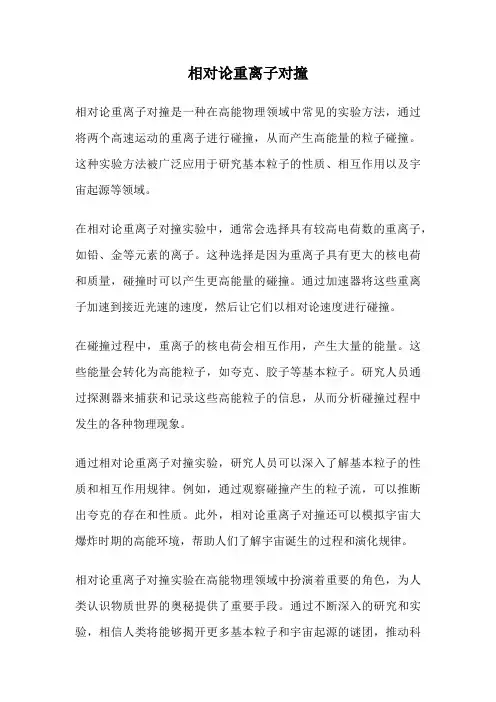
相对论重离子对撞
相对论重离子对撞是一种在高能物理领域中常见的实验方法,通过将两个高速运动的重离子进行碰撞,从而产生高能量的粒子碰撞。
这种实验方法被广泛应用于研究基本粒子的性质、相互作用以及宇宙起源等领域。
在相对论重离子对撞实验中,通常会选择具有较高电荷数的重离子,如铅、金等元素的离子。
这种选择是因为重离子具有更大的核电荷和质量,碰撞时可以产生更高能量的碰撞。
通过加速器将这些重离子加速到接近光速的速度,然后让它们以相对论速度进行碰撞。
在碰撞过程中,重离子的核电荷会相互作用,产生大量的能量。
这些能量会转化为高能粒子,如夸克、胶子等基本粒子。
研究人员通过探测器来捕获和记录这些高能粒子的信息,从而分析碰撞过程中发生的各种物理现象。
通过相对论重离子对撞实验,研究人员可以深入了解基本粒子的性质和相互作用规律。
例如,通过观察碰撞产生的粒子流,可以推断出夸克的存在和性质。
此外,相对论重离子对撞还可以模拟宇宙大爆炸时期的高能环境,帮助人们了解宇宙诞生的过程和演化规律。
相对论重离子对撞实验在高能物理领域中扮演着重要的角色,为人类认识物质世界的奥秘提供了重要手段。
通过不断深入的研究和实验,相信人类将能够揭开更多基本粒子和宇宙起源的谜团,推动科
学技术的发展,造福人类社会。
总的来说,相对论重离子对撞是一种重要的实验方法,通过这种方法可以深入研究基本粒子和宇宙起源等重要问题。
相信随着技术的不断进步和实验的不断深入,人类对物质世界的认识将会不断扩展,科学技术也将迎来新的突破和发展。
相对论重离子对撞实验的未来发展将会为人类带来更多的科学发现和技术创新,推动人类文明的进步和发展。
相对论性重离子碰撞实验相对论性重离子碰撞实验是现代物理学中的重要研究领域之一。
通过加速器将重离子加速到接近光速,然后使其相互碰撞,科学家们可以研究高能量、高密度和高温度下的物质行为,以及宇宙早期的宏观结构和宇宙射线的起源等重要问题。
本文将介绍相对论性重离子碰撞实验的背景、实验装置和研究成果。
一、背景相对论性重离子碰撞实验起源于20世纪70年代,当时人们开始意识到通过高能量的重离子碰撞可以模拟宇宙早期的高温高密度条件。
相对论性重离子碰撞实验的目标是研究夸克-胶子等离子体(QGP),这是一种由夸克和胶子组成的物质态,它在宇宙早期的宏观结构形成过程中起着重要作用。
二、实验装置相对论性重离子碰撞实验通常使用大型强子对撞机(如LHC、RHIC 等)进行。
这些加速器能够将重离子(如铅离子、金离子等)加速到接近光速,并使其相互碰撞。
实验装置主要包括加速器、碰撞区和探测器。
1. 加速器:加速器是将重离子加速到高能量的关键设备。
它通常由一系列加速器组成,包括线性加速器、环形加速器和储存环。
这些加速器通过电场和磁场的作用,逐渐将重离子加速到接近光速。
2. 碰撞区:碰撞区是重离子相互碰撞的地方。
在碰撞区,重离子束会发生碰撞,产生高能量和高密度的物质。
为了实现高能量的碰撞,科学家们通常会采用双束设计,即两束重离子相向而行,碰撞时能量更高。
3. 探测器:探测器用于记录碰撞后产生的粒子和能量。
探测器通常包括径迹探测器、能量测量器和粒子鉴别器等。
通过分析探测器记录的数据,科学家们可以研究碰撞后产生的粒子的性质和行为。
三、研究成果相对论性重离子碰撞实验已经取得了许多重要的研究成果,对于理解宇宙早期的宏观结构和宇宙射线的起源等问题具有重要意义。
1. 夸克-胶子等离子体:通过相对论性重离子碰撞实验,科学家们成功地创建了夸克-胶子等离子体。
夸克-胶子等离子体是一种高温高密度的物质态,它在宇宙早期的宏观结构形成过程中起着重要作用。
研究夸克-胶子等离子体可以帮助我们更好地理解宇宙的起源和演化。
相对论重离子对撞
相对论重离子对撞是指在高能物理实验中,将两个重离子(如铅、钨等)加速到接近光速的状态下进行碰撞,以研究高能物理学中的基本粒子和宇宙学等领域的问题。
相对论重离子对撞实验的历史可以追溯到20世纪80年代,当时欧洲核子研究组织(CERN)和布鲁克海文国家实验室(BNL)分别开始了铅离子对撞实验。
这些实验旨在研究高能密度物质的行为,以及在极端条件下的物质状态。
在相对论重离子对撞实验中,两个重离子在加速器中被加速到极高的能量,然后在探测器中相撞。
这种碰撞会产生大量的次级粒子,包括夸克、胶子、介子等,这些粒子会在探测器中被探测到并记录下来。
通过分析这些次级粒子的性质和行为,科学家可以了解高能密度物质的性质和行为,以及探索宇宙学和基本粒子物理学等领域的问题。
相对论重离子对撞实验的一个重要成果是发现了夸克-胶子等离子体(QGP),这是一种极端高温高能密度的物质状态,类似于宇宙大爆炸初期的物质状态。
通过研究QGP,科学家可以了解宇宙大爆炸初期的宇宙学和基本粒子物理学等问题。
相对论重离子对撞实验还有其他的重要成果,例如发现了新的粒子、研究了强子物理学、探索了宇宙学和黑洞等领域的问题。
这些成果对现代物理学的发展和人
类对宇宙的认识有着重要的贡献。
总之,相对论重离子对撞实验是一种重要的高能物理实验,它可以帮助科学家了解高能密度物质的性质和行为,探索宇宙学和基本粒子物理学等领域的问题,对现代物理学的发展和人类对宇宙的认识有着重要的贡献。
arXiv:nucl-ex/0405009v1 13 May 2004February8,200821:23ProceedingsTrimSize:9inx6inlakeLouiseProceedingsANISOTROPICFLOWINULTRA-RELATIVISTICHEAVY-IONCOLLISIONS
MARKUSD.OLDENBURG(fortheSTARcollaboration)ErnestOrlandoLawrenceBerkeleyNationalLaboratoryOneCyclotronRoad,Berkeley,CA94720,USAE-mail:MDOldenburg@lbl.gov
Theanalysisofanisotropicflowofparticlescreatedinhighenergyheavy-ioncolli-sionsgivesinsightintotheearlystageofthesereactions.Measurementsofdirectedflow(v1),ellipticflow(v2)andflowof4thand6thorder(v4andv6)arepresented.Whilethestudyofv2formulti-strangeparticlesestablishespartoniccollectivitytheresultsforhigherorderanisotropiesconstraintheinitialconditionsofhydro-dynamicmodelcalculations.
1.Heavy-ioncollisionsHigh-energycollisionsofheavyionsprovideatooltostudynuclearmat-terunderextremeconditions.Inthecollisionoftworelativisticnuclei,ahotanddensesystemofpartonicmattermayform.Duringtheformationtime(oftheorderofτ0∼1fm/c),partonsfromthecollidingnucleisufferhardscatterings.High-pThadronsarepredominantlyproducedinthesehardscatteringsand,therefore,carryinformationaboutthisearlystage.Ifthesystemisthermalizedandtherelevantdegreesoffreedomarepartonicthenthestateofmattercreatedisreferredtoasthequark-gluonplasma.DuetoarapidexpansionthesystemcoolsandatacriticaltemperatureTcundergoesaphasetransitiontohadronicmatter1.Thiscriticaltem-peratureTcmightbeclosetothetemperatureofchemicalfreeze-outTch,atwhichthelastinelasticscatteringsoccurandparticleyieldsnolongerevolve.ThushadronabundancesprovideinformationaboutthesystematTch(∼Tc).Thesystemfurtherexpandsandelasticscatteringceases.Thecorrespondingtemperatureiscalledthekineticfreeze-outtemperatureTfo.Afterkineticfreeze-outthemomentaoftheproducedparticlesarefixed.ThereforethemomentumdistributionsreflectthepropertiesofthesystematTfo.
1February8,200821:23ProceedingsTrimSize:9inx6inlakeLouiseProceedings2Insummaryonehastonotethatthediscussedsignalsoftheearlyandmostinterestingstageofthesystem’sevolutionarecarriedbyonlyatinyfractionofallproducedparticles,namelythosewithhightransversemomentumpT.
2.AnisotropicflowInnon-centralheavy-ioncollisionstheoverlapregionofthetwocollidingnucleiisnotazimuthallysymmetricinthetransverseplane.Thisleadstoalargerpressuregradientinthereactionplane(definedbytheincidentbeamdirectionandtheimpactparameter)thanout-of-plane.Thesepressuregradientstransformtheoriginalspatialanisotropyofthesystem(whichisout-of-plane)inanin-planeanisotropyinmomentumspace.Duringthisevolutionthespatialanisotropydiminishesandtheprocessofgeneratinganisotropiesinmomentumspacequenchesitself.Themeasurementofthefinalazimuthalmomentumanisotropyisthereforeasignalwhichiscarriedbyallparticles,pointsbacktotheearlyevolutiontimesofthecollision,andprovidesinformationabouttheequationofstateofthegeneratedtypeofmatter.ThetransversemomentumasymmetryisanalyzedutilizingaFourierdecompositionofthemomentumdistributionineacheventwithrespecttothereactionplane2.BydoingthisoneextractsFouriercoefficientsofdifferentordern:vn≡cos(n·φ),whichcharacterizethestrengthofdifferentordersofflow.v1andv2arecalleddirectedandellipticflow,respectively.
3.TheSTARexperimentTheSTARexperiment3attheRelativisticHeavyIonCollider(RHIC)mea-sureschargedhadronsoverawiderangeinpseudorapidityηandtransversemomentumpT.ItsmaindetectorisalargeTPC,sittinginamagneticfieldof0.5T.Withintheacceptanceof|η|<1.0particlesareidentifiedbyspe-cificenergylossdE/dx.ThetwoForward-TPCs(FTPCs)addtheregionof2.5<|η|<4.0totheoverallacceptance.Otherdetectorsubsystems,whichwerenotusedinthestudiesshownhere,includeasiliconvertextracker,anelectromagneticcalorimeterandtime-of-flightpatches.AllresultspresentedherewereobtainedusingAu+Aucollisionsatacenterofmassenergyof√February8,200821:23ProceedingsTrimSize:9inx6inlakeLouiseProceedings34.Ellipticflowv2
Inadditiontothelargeoverallellipticflowv2ofseveralpercent4,whichsuggestsastronglyanisotropiccollectiveexpansion,themeasurementofv2
showsastrongdependenceonpT(seeFig.1,left).Thealmostlinearriseof
v2(pT)uptopT∼1.5GeV/ccanforthefirsttimebereproducedbyhydro-dynamicmodels5,whichoverpredictellipticflowatlowercollisionenergies.Thesemodelsassumelocalthermalequilibrium.Themassdependenceofv2(pT)atlowpTagreeswiththesemodelsaswell,withlighterparticlesexperiencingmoreellipticflow.Thisisconsistentwithallparticlesflowingwithinthesamevelocityfield,sinceheavierparticleshavelargermomentumforthesamevelocity.
(GeV/c)Tp01234562v
00.050.10.150.20.250.3
s0 K Λ+Λ
+Ξ+-Ξ +Ω+-Ω
π Ω
ΞBlastWave fit to Hydro model